- Career Blog

Creating a Resume with No Experience: 25 Examples and Tips

As a job seeker with no prior work experience, creating a compelling resume can be challenging. It’s tough to craft a document that captures the attention of potential employers, especially when you don’t have a proven track record to showcase.
However, a well-crafted resume is critical in getting your foot in the door and securing those crucial first interviews. It’s your chance to make a great first impression and demonstrate your skills, knowledge, and potential as a valuable employee.
In this article, we’ll walk you through the process of creating a standout resume with no experience. We’ll provide you with 25 examples and tips to help you develop a resume that speaks to your strengths and positions you as a strong candidate.
Whether you’re fresh out of school, changing career paths, or have been out of work for some time, we’ll help you create a resume that gets you noticed. By the end of this article, you’ll have a better understanding of how to showcase your skills, highlight your accomplishments, and get your resume to the top of the pile.
So, let’s dive in and explore the challenge of creating a resume with no experience, the importance of a well-crafted resume, and the objective of this article.
Resume Basics
Defining a resume and its purpose.
A resume is a document that summarizes your work experience, education, skills, and accomplishments. It is often the first point of contact with potential employers and serves as a critical tool in your job search. The primary purpose of a resume is to get you an interview.

Different Resume Formats
There are several different resume formats, each with its own advantages and disadvantages. The most common formats include:
Chronological Resume
A chronological resume is the most traditional format and is what most people think of when they hear the word “resume.” It lists your work experience in reverse chronological order, starting with your most recent job. This format is best for people with a consistent work history.
Functional Resume
A functional resume focuses on your skills and accomplishments rather than your work history. It includes sections for your skills, education, and work experience, but places more emphasis on your skills and accomplishments. This format is best for people who are changing careers, have gaps in their work history, or are just starting their careers.
Combination Resume
A combination resume combines elements of both the chronological and functional formats. It includes sections for your skills, accomplishments, and work experience, but lists your work history in reverse chronological order. This format is best for people with a strong work history who also want to highlight their skills and accomplishments.
How to Choose the Right Resume Format
Choosing the right resume format can be a daunting task, but it is an important one. The format you choose can make a significant difference in how your resume is perceived by potential employers. Here are some factors to consider when choosing the right resume format for you:
Your Work History
If you have a consistent work history with no gaps, a chronological resume may be the best choice for you. It allows you to showcase your work experience in a clear and concise manner.
If you have gaps in your work history, a functional or combination resume may be a better choice. These formats allow you to highlight your skills and accomplishments instead of focusing solely on your work history.
Your Career Goals
Your career goals can also play a role in determining the right resume format for you. If you are changing careers or just starting out, a functional or combination resume can help you highlight your skills and accomplishments in a way that is relevant to your new career path.
If you are applying for a job in a field where your work history is especially important, such as academia or law, a chronological resume may be the best choice.
The Job Posting
Finally, it is important to consider the specific job posting when choosing your resume format. Look at the job description and requirements and tailor your resume accordingly. If the job posting emphasizes specific skills or accomplishments, make sure to highlight them in your resume.
Choosing the right resume format is an important step in creating a resume that will get you noticed by potential employers.
Elements of a Resume
When creating a resume, there are several key elements that every job seeker should include. These elements will help you stand out from the crowd, show off your qualifications, and give potential employers an idea of what you have to offer. Below are five key elements that should be included in any resume, even if you have no prior work experience.

Contact Details
The first and most important element of any resume is your contact information. This includes your full name, email address, phone number, and mailing address. Make sure that your email address is professional and easy to identify, and that your phone number is clearly listed and up-to-date. In addition, consider including links to your LinkedIn profile, personal website, or any other relevant social media accounts.
Objective or Summary Statement
Another important element to include in your resume is an objective or summary statement. This statement should be a brief summary of your skills and qualifications, and should be tailored to the specific job you are applying for. For example, if you are applying for a job in marketing, your objective statement might highlight your experience with social media and content creation.
Regardless of your work experience, your education is an important factor to include on your resume. This can include any degrees, certifications, or relevant coursework you have completed, as well as any significant academic achievements such as being on the Dean’s List.
When writing your resume, be sure to include a section highlighting your skills. This should include any technical skills or language proficiencies that are relevant to the job you are applying for. For example, if you are applying for a job as a software developer, you might include skills such as fluency in Java or experience working with databases.
Relevant Coursework and Projects
Finally, if you have little to no work experience, it can be helpful to include relevant coursework or projects that demonstrate your skills and experience. For example, if you have completed a class in web development, you might list a project you completed that showcases your web development skills.
By including all of these elements in your resume, you can make a strong impression even if you have no prior work experience. Remember to be concise, clear, and tailored to the specific job you are applying for, and you will be well on your way to landing your dream job.
Write an Eye-catching Headers
As crucial as the content of a resume is, the header, or the first thing a prospective employer or hiring manager sees, could make or break the candidate’s chances of landing the job. For job seekers with no experience, it’s even more essential to craft a catchy header that grabs attention and leaves a positive first impression.
Here are some tips on how to craft a header that will stand out:
How to craft a catchy header
- Keep it simple: Avoid complicated fonts or formats that could distract from the message. Stick to a basic font, such as Arial or Times New Roman, and make sure the header is easy to read and understand.
- Use keywords: Use keywords directly related to the job posting or industry to increase the chances of being selected in the initial screening.
- Highlight relevant skills or achievements: If you have any relevant skills or achievements, make sure to include them in the header. For example, if you have experience in customer service, put that in the header to show you have the necessary skills for the job.
- Personalize it: Tailor your header to the company and what you can offer. Research the company and find out what they are looking for in a candidate, and use that information to personalize your header.
Examples of headers that grab attention
- Nurse with Strong Patient Care Skills
- Recent Graduate with Excellent Communication and Problem-Solving Skills
- Dependable Customer Service Representative with Proven Track Record
- Hardworking Entry-Level Employee with Strong Work Ethic
- Enthusiastic and Detail-Oriented Graphic Designer
- Reliable Administrative Assistant with Strong Organizational Skills
- Driven Sales Associate with Outstanding Customer Relations Skills
By following the above tips and crafting a header that stands out, job seekers with no experience can significantly increase their chances of getting noticed by potential employers.
Highlighting Skills and Experience
If you have no work experience, highlighting your skills is a great way to make your resume stand out. Here are some tips on how to do that:
1. How to include relevant skills even if you have no experience
First, identify the skills that are most relevant to the job you are applying for. These skills can be hard skills (quantifiable skills like proficiency in a particular software or language) or soft skills (interpersonal skills like communication and teamwork).
Next, search for opportunities to develop and showcase those skills. You may have gained these skills through volunteer work, academic projects, or even hobbies. Be sure to highlight these experiences in your resume and emphasize how they have prepared you for the role you are applying for.
2. Showcasing skills acquired in non-work situations
Even if you haven’t held a traditional job, you may have still gained valuable skills through non-work situations. For instance, if you have been a dedicated volunteer for a charity, you may have developed skills like planning and organizing events, fundraising, or working with others to achieve a common goal.
Similarly, if you have been pursuing a hobby like photography or graphic design, you may have gained skills in editing, creative problem solving or time management that could be relevant to certain roles. These experiences can be highlighted in your resume as well.
3. Listing extracurricular activities
Extracurricular activities can also be a great way to showcase your skills and demonstrate your interests to potential employers. For instance, if you volunteered at a food bank, you may have developed teamwork and communication skills while working with other volunteers to pack and distribute food. Or, if you served as the captain of your school sports team, you may have developed leadership and problem-solving skills during games and practices.
Highlighting your skills can show employers that you have the potential to succeed in their organization, even if you do not have traditional work experience. Use these tips to effectively showcase your skills and increase your chances of landing an interview.
Mention Projects and Coursework
As a candidate with little to no work experience, highlighting relevant projects and coursework can showcase your skills and knowledge.
Relevant Coursework
When choosing which coursework to include on your resume, consider courses that align with the job you’re applying for. For example, if you’re applying for a marketing position, you might include coursework on brand strategy, digital marketing, and consumer behavior.
Courses can also demonstrate your work ethic, intellectual curiosity, and ability to learn new skills. If you received high grades in challenging courses, make sure to highlight this achievement on your resume.
Projects and Achievements
Projects and achievements can provide concrete examples of your skills, creativity, and resourcefulness.
When listing projects on your resume, choose ones that are relevant to the job you’re applying for. For example, if you’re applying for a graphic design position, you might include projects where you created logos, graphics, or website design.
Achievements can include awards, scholarships, or recognitions you’ve received for your work. If you’ve completed a particularly challenging project, or if you’ve received recognition for academic or extracurricular achievements, make sure to include these on your resume.
Highlighting relevant coursework and projects can demonstrate that, despite your lack of work experience, you have the skills and knowledge necessary to excel in the job you’re applying for.
Mastering the Resume Objective
One of the most crucial components of your resume is your objective statement. It is the first thing that recruiters and hiring managers see, and it provides a glimpse into your goals and aspirations. Hence, it should be concise, clear, and powerful, giving an indication of what you want to achieve in your career.
Writing an effective objective statement
To write an effective objective statement, you need to keep it brief and focused. You should highlight the job you are seeking, your relevant skills, and what you can bring to the position. Moreover, it should be tailored for each role, ensuring that the objective reflects the requirements listed in the job description.
Here are some tips for writing a resume objective statement:
- Keep it concise and to the point.
- Emphasize your career goals and objectives.
- Show what you can bring to the company.
- Tailor it to the job description.
- Avoid generic statements.
Examples of great objective statements
To give you an idea of what a great objective statement looks like, here are some examples:
- Seeking an entry-level position in the marketing field, where I can utilize my excellent analytical and communication skills to contribute to the company’s growth.
- To obtain a position as a software developer, where I can use my programming skills and passion for creating user-friendly software to develop innovative applications.
- Looking for a challenging role as a financial analyst, where I can leverage my financial modeling and data analysis skills to provide valuable insights for the organization.
- An ambitious recent graduate seeking a position as a management trainee in a dynamic organization where I can learn and grow while making a positive impact.
- Seeking a customer service position where I can leverage my excellent communication skills to provide impeccable service and contribute to the company’s success.
Your resume objective statement should be tailored to each job and show what you bring to the role. A well-written objective statement can grab the attention of recruiters and take you one step closer to landing your dream job.
Resume Layout and Design
When it comes to creating a resume, the layout and design are just as important as the content itself. A well-designed resume can make a big difference in catching a potential employer’s eye and setting yourself apart from other candidates. Here are some tips for choosing the best resume layout:
- Keep it simple and easy to read: Avoid cluttering your resume with too many fonts, colors, or graphics. Stick to a clean design that is easy on the eyes and makes your information easy to digest.
- Focus on hierarchy: Use different fonts and font sizes to create a clear hierarchy of information. For example, your name and job title should be larger than your contact information.
- Use bullet points: Bullet points make your resume easier to skim and highlight your achievements and qualifications.
- Use white space: Don’t be afraid of leaving some empty space on your resume. This can help create a clean, organized look.
Now that you know the basics of resume layout, let’s talk about some creative resume layout examples that can help you stand out from the competition. Here are some ideas:
The infographic resume: This type of resume uses graphics and charts to convey your skills and experience. It’s a great option if you work in a visually-oriented field like design or marketing.
The timeline resume: A timeline resume showcases your career trajectory in a visual way. You can use a line graph or a horizontal timeline to show your employment history and key achievements.
The minimalist resume: Sometimes less is more. A minimalist resume uses simple, clean design elements to create a sleek, professional look. This can be a good choice if you work in a conservative field like finance or law.
The personal branding resume: This type of resume focuses on showcasing your personal brand. You can use color, fonts, and graphics to create a unique look that reflects your personality and values.
The video resume: A video resume is a great way to showcase your personality and communication skills. You can create a short video introducing yourself, highlighting your skills and accomplishments, and explaining why you’re the best candidate for the job.
These are just a few examples of the many creative resume layouts out there. When choosing a layout, think about your industry, your personality, and your target audience. With a little bit of creativity and design know-how, you can create a resume that will help you land your dream job, even without experience.
Tailoring Your Resume
When it comes to job hunting, sending out a generic resume for each job application is one of the biggest mistakes you can make. It’s important to customize your resume to suit each job application in order to increase your chances of getting noticed by employers.
Here are some tips to help you tailor your resume for specific job applications:
Customizing your resume for specific job applications
Customizing your resume for each job application shows employers that you have taken the time and effort to research the company and the role you are applying for. This can help you stand out from other applicants and increase your chances of landing an interview.
One way to customize your resume is by highlighting your relevant skills and experience for the specific job you are applying for. You can also showcase your achievements and accomplishments that directly align with the job requirements.
How to match keywords with job descriptions
To further customize your resume, it’s important to match your keywords with the job description. Keywords are important because many employers use applicant tracking systems (ATS) to sort through resumes.
Here’s how you can match keywords with job descriptions:
- Read the job description carefully and identify the keywords and skills that the employer is looking for.
- Use those keywords throughout your resume, especially in the skills and experience sections.
- Don’t just copy and paste the job description into your resume. Use the keywords in a natural and genuine way that showcases your skills and experience.
- Use industry-specific jargon and terminology that aligns with the job description.
Customizing your resume for specific job applications and matching your keywords with job descriptions can greatly increase your chances of getting noticed by employers. Take the time to research the company and the job requirements, and tailor your resume accordingly. Good luck!
Creating an Online Presence
In today’s digital age, having a strong online presence is crucial for any job seeker. With no prior work experience, creating an online presence is even more important as it can help showcase skills, talents, and achievements.
One of the best ways to create a professional online presence is by building an impressive LinkedIn profile. LinkedIn is the world’s largest professional networking platform that allows job seekers to connect with employers, industry thought leaders, and colleagues in their respective fields. To build an impressive LinkedIn profile, one should have a professional profile picture, a catchy headline that summarizes their professional identity, a well-written summary, and a list of relevant skills. In addition, job-seekers should also try to get endorsements and recommendations from colleagues, managers, and mentors.
Apart from LinkedIn, there are other online platforms that one can use to showcase their professional skills. For instance, if the job-seeker is interested in pursuing a career in design, they can create an online portfolio on platforms like Behance, Dribbble, or Coroflot, showcasing their design projects. If the job seeker is interested in writing, they can showcase their writing samples on platforms like Medium or Contently. They can also start a blog to showcase their writing skills and their interests in the particular field.
In addition to creating an online portfolio or a blog, job seekers can also leverage social media platforms like Twitter, Instagram, or Facebook to showcase their professional interests, industry knowledge, and achievements. However, it’s important to note that one should always maintain a professional tone on social media and not post anything that may harm their career prospects.
Creating an online presence is a vital part of any job search process for a candidate with no prior work experience. It helps to establish a professional identity, showcase skills and achievements, and connect with professionals in their respective fields. By building an impressive online presence, job-seekers can increase their chances of landing their dream job.
Tips for Cover Letter
A well-crafted cover letter can be the key to landing your dream job, even if you have no prior experience in the field. The purpose of a cover letter is to introduce yourself to the employer and showcase your skills and qualifications.
Here are some things you should include in your cover letter:
Purpose of a Cover Letter
Introduction: Begin by introducing yourself and explaining why you are interested in the position.
Highlight your skills: Provide examples of your skills and achievements that make you a good fit for the position.
Show your enthusiasm: Express enthusiasm for the position and the company.
Explain why you are a good fit: Demonstrate how your skills and experience align with the requirements of the job.
Call to action: End your letter by asking for an interview and providing your contact information.
What to include in a Cover Letter
Your contact information: Include your full name, address, email, and phone number.
Employer’s information: Include the employer’s name, title, company, and address.
Salutation: Address the letter to the hiring manager by name.
Opening paragraph: Introduce yourself and state the position you are applying for.
Body paragraphs: Use one or two paragraphs to highlight your skills, experience, and qualifications.
Closing paragraph: Thank the employer for considering your application and request an interview.
Closing salutation: Use a professional closing, such as “Sincerely” or “Best regards.”
Signature: Sign your name and include a digital copy of your signature if submitting online.
Examples of Great Cover Letters
Here are some examples of great cover letters:
A recent college graduate applying for an entry-level marketing position could highlight their experience with social media and their passion for the industry.
A career change candidate could explain how their transferable skills and experience make them a strong fit for the new field.
An applicant with volunteer or internship experience could highlight their work ethic and willingness to learn.
When crafting your cover letter, make sure to highlight your strengths and show your enthusiasm for the position. With these tips, you’ll be on your way to creating an effective cover letter that sets you apart from the competition.
Common Mistakes to Avoid
If you’re creating a resume with no experience, it’s important to be aware of the common mistakes that many job seekers make. Here are some of the most prevalent mistakes to avoid:
1. Overemphasizing education:
If you have little or no experience, you might be tempted to overemphasize your education on your resume. While it’s important to include your educational background, remember that employers are often more interested in your skills and experience. Make sure to highlight any internships, volunteer work, or extracurricular activities that showcase your skills, even if they weren’t related to your academic studies.
2. Lack of customization:
Sending out the same generic resume for every job application is a common mistake that can significantly decrease your chances of getting hired. Employers can tell when a resume has been copy-pasted, and it shows a lack of effort on your part. Instead, make sure to tailor your resume to the specific job you’re applying for by highlighting the skills and experiences that match the job requirements.
3. Including irrelevant information:
When you have no experience, it can be tempting to include everything on your resume, whether it’s relevant or not. However, including irrelevant information can dilute the impact of your resume and make it harder for employers to see why you’re a good fit for the job. Stick to including only the most relevant information and experiences, and leave off anything that doesn’t add value to your job application.
4. Neglecting to proofread:
Spelling and grammar mistakes can quickly sink your chances of getting hired. Employers are looking for candidates who pay attention to detail, so make sure to thoroughly proofread your resume for any errors. You may also want to ask a friend or mentor to review your resume to help catch any mistakes that you may have missed.
To avoid these common mistakes, keep these tips in mind:
- Focus on showcasing your skills and experiences, even if they’re not directly related to your education.
- Customize your resume for each job application to highlight your most relevant experiences and skills.
- Stick to including only the most relevant information, and leave out anything that doesn’t add value to your job application.
- Proofread your resume thoroughly for spelling and grammar mistakes to demonstrate your attention to detail.
By avoiding these common mistakes, you can create a strong, targeted resume that showcases your strengths and positions you as a strong candidate for even the most competitive job opportunities. Good luck with your job search!
Related Articles
- Regional Sales Manager Resume: Examples and Tips for 2023
- QA Team Lead Job Description: Complete Guide for 2023
- Resume for a Part-Time Job: A Complete Guide for 2023
- Securities Analyst Resume Samples: Complete Guide for 2023
- Personal Mission Statements: Perfect Statement for 2023
Rate this article
0 / 5. Reviews: 0

More from ResumeHead

Protect your data
This site uses cookies and related technologies for site operation, and analytics as described in our Privacy Policy . You may choose to consent to our use of these technologies, reject non-essential technologies, or further manage your preferences.
- Resume and Cover Letter
- Guide to Writing a Great...
Guide to Writing a Great Resume with No Work Experience
16 min read · Updated on February 13, 2024

No work experience? No problem.
The ol' catch-22: you need a job to get experience, but you need experience to get a job. Either way, you need a resume, and what you don't need is to panic.
Just because you don't have skills that are relevant to the job, or experience in a traditional work setting, doesn't mean you can't craft a convincing first job resume. Whether you're a high school or college student, you may be wondering: how do you write a resume with no work experience? Well, we'll tell you with these expert tips.
1. Choose the best format for a resume with no experience
There are a few dominant resume templates in use today:
Chronological
Hybrid - a blend of the chronological and functional formats
A chronological resume format lists a candidate's work experience in reverse-chronological order and a functional resume format focuses on highlighting the candidate's hard and soft skills and achievements, rather than work experience. While the functional and hybrid resume formats can be attractive options for job seekers with little relevant experience, most employers and hiring managers prefer a chronological format.
Aside from hiring managers preferring it, it's best to use a reverse chronological resume for two additional reasons:
It's the most used format in the US, making it easy for hiring managers to review and find the information they're seeking
It's the most liked by employers' applicant tracking systems, or ATS. If an ATS can't read your resume properly, it might not get into the hands of a human reader - even if you're the perfect candidate for the job
The primary sections of a reverse chronological resume are:
The heading (with your contact information)
Resume summary
Work experience (which will be substituted with other sections when you have no work experience)
Education
2. Incorporate your contact information
Now that you've chosen the best format for a resume with no experience, it's time to complete each section. The first section of your resume is the header section. This is the section that includes your name and contact information. In this section, you'll provide:
Phone number
Email address
Location and zip code
LinkedIn or professional website URL (optional)
Your name should sit above your contact information in a larger font size than the rest of the information included in the header. You also want to ensure you use a professional sounding email address. Using something like “[email protected]” or “[email protected]” will likely come across as unprofessional and won't gain you any points for the “yes” pile. A good choice is to use your name (or a combination of your initials and surname), instead.
Here's an example of how to list your contact information at the top of your resume:
Joseph Smith
555.555.5555 | [email protected] | WV 26250 | linkedin.com/in/jsmith28
3. Include a strong summary statement
The next section of your resume, your Resume Summary, will fall just below your contact information. Your resume summary is not to be mistaken for a resume objective.
Resume objective statements , where you state exactly what career goals you wish to achieve, have mostly fallen out of fashion. This is largely because you want to focus on what you can do for the employer, not what the employer can do for you. A resume summary statement, on the other hand, sums up who you are professionally at the top of the page in two to five sentences and serves as the first impression you give a hiring manager to entice them to keep reading.
For a resume with no experience, your resume summary can still pack a punch. Include some of the key skills you have relevant to the job, while emphasizing your major and any type of experience that speaks to your ability to succeed.
Here's an example of a resume summary for a recent grad with a human resources degree:
Human resources graduate with diverse knowledge base in employee relations, benefits design, employment law, and policy design. Avid learner with solid written and verbal communication skills and a strong desire to support all levels within an organization for improved employee morale and productive collaboration.
4. Substitute the Work Experience section with other types of experience
Writing a resume with no experience can feel like a daunting task. Fortunately, recruiters and hiring managers are seeking candidates that have a robust background, regardless of experience level. Here are some sections you can substitute in lieu of a Work Experience section:
Internships
Graduate assistantships, extracurricular activities.
Volunteer Work
Hobbies and Interests
When you include these additional types of experiences on a resume, you can include them as a standalone section or create a “Relevant Experience” section. Depending on the type of experience you're including, you might find it's best to use a section heading that aligns with the type of experience (“Internships” for internships, “Volunteer Work,” for volunteer work, and so on).
Landing paid or unpaid college internships are one of the best weapons you have against "experience required." Not only do they give you some real-world work experience, they also allow you to network and make connections that can put you in a job later. When applying for a job without experience, be sure to list any internships you've completed.
If you haven't had an internship, consider applying for one as a step before an entry-level job.
Here's an example of how to include an internship on your resume:
Finance Intern
New York Secretary of State Office, New York, NY
Jan 2021 - May 2021
Reconciled budget sheets for quarterly processing
Supported accounting team in year end tax return audits
Analyzed 15 budget reports over a two-month period to ensure accurate data reporting
Similar to internships, a graduate assistantship secured during school is also a great way to gain valuable experience to include on a resume. Graduate assistantships are paid opportunities provided to graduate students. They typically involve part-time teaching or research within their field of study.
Here's an example of how to include an assistantship on your resume:
HR Graduate Assistant
West Virginia University School of Business and Economics, Morgantown, WV
August 2020 - May 2021
Reviewed 100 collective bargaining agreements to identify and document similarities and inconsistencies throughout
Worked with academic Professors to develop research guidelines for future assistants
Volunteer work
When surveyed, the majority of employers say that they take volunteer experience listed on your resume , such as being a soup kitchen volunteer, into consideration alongside paid work experience. So any volunteer work that highlights your talents or a new skill should be put on your well-prepared resume.
You'll list volunteer work in a similar way to how you would list internships and actual work experience:
Animal Transport Volunteer
Friends for Life Animal Shelter, Philippi, VA
April 2022 - Present
Working with local shelters to transport animals to and from shelters and foster homes
Assisting in cleaning kennels and common areas to support sanitation efforts
Spearheading animal supply drive, collecting $10K worth of supplies
Though it might not seem like it at first, extracurricular activities can add a lot of value to your resume in lieu of work experience, if you can relate them to the job you're applying to. For example, if you were an officer for a club during college or a captain of a sports team, these roles speak to leadership ability.
In general, these types of activities show you have the ability to collaborate with others. It also shows you have the ability to keep up with school work while being involved in other areas outside of school, which speaks to time management and organizational skills.
Here are some of the top extracurricular activities to include on a resume with no experience, as well of some of the skills they help to highlight:
Artistic endeavors: speaks to creativity, problem solving, perseverance, ability to learn
Sports: speaks to teamwork, collaboration, hard work, problem solving, conflict resolution
Club leadership roles: speaks to leadership, organization, perseverance, time management
General club membership: speaks to time management, community involvement, prioritizing
Student government: speaks to leadership, public speaking, time management, problem solving, organization
Here's an example of how to list extracurricular activities on a resume with no experience:
Student Council Vice PresidentBelington High SchoolAugust 2020 - May 2021
Spearheaded clothing drive to support the homeless in the state of Virginia
Wrote and delivered 3 speeches to the student body focused on student wellbeing, fundraising events, and life beyond high school
Special Projects
If you completed job-related projects during high school or college, they can be a valuable addition to your resume. Personal projects are also game for a resume with no experience, if they're relevant to the job.
Here's how you might list a personal project on your resume:
Social Media Campaign
Sparkle and Shine Fundraising Event
February 2022 - Mar 2024
Created social media campaign to support fundraising efforts for local children's shelter, supporting education in underprivileged youth
Increased followers by 25% in two months
Generated leads that converted to $3,000 in donations
Here's how you might list school projects on your resume:
Beaumont University
Masters in Counseling and Development
Career counseling planning design for women with chronic fatigue syndrome
Group counseling proposal for friends and family members of those who have mental health challenges
Behavioral health program design to work with males ages 18 to 30 with adverse childhood experiences
Hobbies and interests
It's more common today than ever before to include hobbies and interests on a resume - they help to provide insights into who you are as a person, to enhance your resume story. Hobbies and interests require soft and hard skills, many of which are required to succeed on the job, and they can especially be useful to fill in gaps when you lack work experience.
For additional information on how to list hobbies and interests on your resume with no experience, refer to “ How to List Hobbies and Interests on a Resume (With Examples) .”
An award can signal to an employer to take note, since they're a distinction that speaks to your skills, abilities, and accomplishments. Adding an Awards section is an excellent way to showcase your ability to succeed in lieu of work experience.
When you list an award, include the award and issuing institution. For example:
2023 Science Olympiad Award recipient, Science Olympiad Foundation
Certifications
Acquiring certifications provides an excellent opportunity to add value and fill in gaps in terms of skills and work experience. There are a lot of opportunities to secure certifications for free through sites like LinkedIn Learning, Udemy, and Grow with Google . Certifications not only highlight your skills but also show that you're focused on personal and professional development, which employers appreciate in candidates.
You can list certifications in a standalone Certifications list or with your Education section. For more information on how to best include certifications on a resume with no experience, refer to “ How to List Certifications on a Resume (with examples) .”
5. Include your education
When you have work experience, it's common to include your Education section after your Work Experience section. However, on a resume with no experience, many opt to list and emphasize their education after the resume summary. This is largely due to the fact that your education is what's most relevant to employers when you're straight out of school.
Also, in lieu of a Work Experience section, especially if you're running thin on any of the relevant experience options listed above, you can expand and focus on the education section on your resume to highlight the marketable skills you've developed. What can you do well that this job requires? What will be useful to the hiring company? What have you done in school and what have you studied that has prepared you for assuming this job?
This is generally a little easier if you're a college graduate with specialized education, but even a high school graduate can talk about their electives and relevant coursework, why they wanted to take them, and what they learned from the class. It's also acceptable to include any awards, scholarships, honors, or any student clubs and committees you participated in. For example, if you were on the Dean's list, include it.
Many also wonder if they should include their GPA on their resume. The short answer is yes, if it's 3.5 or higher. This level of achievement highlights your potential and the hard work you're willing to put in for success.
Here's the order to list items in your Education section, with items 5 to 8 being optional:
Degree issued
Issuing institution
City and state of institution
Graduation date (or expected graduation date, if in progress)
Relevant coursework
Student committees
Here's how your education might look laid out on your resume:
Bachelors of Science - Psychology (3.5 GPA, magna cum laude)Maryland State University
Relevant coursework: human growth and development, assessment, treatment planning, abnormal behavior
6. Emphasize your skills
Even when you don't have actual work experience, you have definitely acquired skills to support you on the job, which can set you apart from the competition. Be sure to highlight both hard and soft skills on your resume. You can do this by including a Skills section near the end, or by adding a Core Competencies section just below your Resume Summary.
You also might be wondering what the difference is between hard and soft skills. Hard skills are technical skills that are measurable and learned. Softs skills are tangible skills that are difficult to measure.
Examples of valuable hard skills on a resume include:
Mathematics
Computer skills
Data analysis
Project management
Social media
Language skills
Here are some common soft skills employers seek in their employees:
Communication
Problem solving
Organization
Interpersonal skills
Time management
Working well under stress
7. Add a cover letter
Even if one isn't required, it's generally a good idea to send a short cover letter along with your resume. Cover letters are where your personality comes out and you can use them to make the case for why you're the perfect candidate for this job.
A standout cover letter can convince an employer to bring you in for an interview, even if your resume itself doesn't have all the things they'd like to see. Your cover letter provides you with the opportunity to show a bit of personality and express why you're interested in the job, as well. Be sure your cover letter uses the same font and style as your resume, for consistency.
Elements you should never include on a resume
While there are many elements you should consider adding to your resume, career experts say there are a few things you should never include because they waste space, don't tell the employer anything relevant, or could damage your personal brand. This list includes, but is not limited to:
Employment references
Writing samples
Photos of yourself
Do not add this information to your resume unless an employer or recruiter asks you to provide it.
Additional tips for a resume with no work experience
As you develop your resume with no experience, here are a few more tips to consider.
Take stock of your achievements and activities
Make a list of absolutely everything you've done that might be useful on a resume. From this list, you'll then need to narrow down what to actually include on your resume. Different things might be relevant to different jobs you apply for, so keep a full list and pick the most relevant things from it to include on your resume when you send it out. This will help you to identify which sections to include in lieu of work experience.
Pay attention to technical details
When editing your resume, make sure there are no punctuation, grammatical, spelling, or other errors that will make your resume look unprofessional. Then, have a friend or family member read it again to catch any mistakes you might have missed — you can't afford a typo or missing word as a candidate with no prior work experience. Also, be sure to vary your language and use action verbs throughout your resume to keep your reader engaged.
Keywords, keywords, keywords!
Most employers use some form of applicant tracking system (ATS) to scan and sort resumes . This may seem unfair, but it's the reality of modern-day hiring. To combat this, you'll want to come up with, and include, a list of keywords in your resume when applying for any job. The best place to find these keywords is in the job post itself, or in ads for similar jobs. One caveat: don't use meaningless "buzzwords," such as "go-getter," "team player," and “detail-oriented." Unfortunately, sometimes these buzzwords are the only keywords listed in the ad. If that's the case, you'll need to sneak them in alongside your detailed accomplishments and academic achievements.
Customize your resume for each job you apply to
The last and most important thing to remember when creating a good resume is to customize it for every job to which you apply . Different job postings are going to have different keywords, different job duties listed, and so on. Appealing to each individual employer's needs and job requirements is the best strategy for getting your application noticed and hopefully landing your first job.
Relevant experience goes beyond work experience
At the end of the day, the only perfect resume is the one that gets you the interview. Regardless of whether you have work experience or not, it's still possible to stand out by highlighting other types of experience that relate to the role.
Even once you're comfortably employed, be prepared to tweak and update your resume to get noticed with each job application you submit. In the meantime, use any type of relevant experience to help you shine and land an interview. Sooner or later, you'll land that job - and gain that much-coveted relevant work experience.
Tackling this kind of resume isn't easy. If you've recently graduated or are in an entry-level job search, a professional resume writer can prepare you for success.
This blog was originally written by Riya Sand and has been updated by Ronda Suder.
Recommended reading:
5 Things You Should Always Include on Your Resume
Should You Include Social Media on Your Resume?
How to Be a Great Candidate Even If You're Under-Qualified for the Job
Related Articles:
How to Maximize Your Resume Action Words to Wow the Employer
Is Your Resume Inspirational? If Not, Here's How to Fix It
7 Ways You Try Too Hard in Job Applications
See how your resume stacks up.
Career Advice Newsletter
Our experts gather the best career & resume tips weekly. Delivered weekly, always free.
Thanks! Career advice is on its way.
Share this article:
Let's stay in touch.
Subscribe today to get job tips and career advice that will come in handy.
Your information is secure. Please read our privacy policy for more information.

How to Write a Resume With No Work Experience in 2024 (+Examples)
- December 5, 2023
- In Resumes & Cover Letters
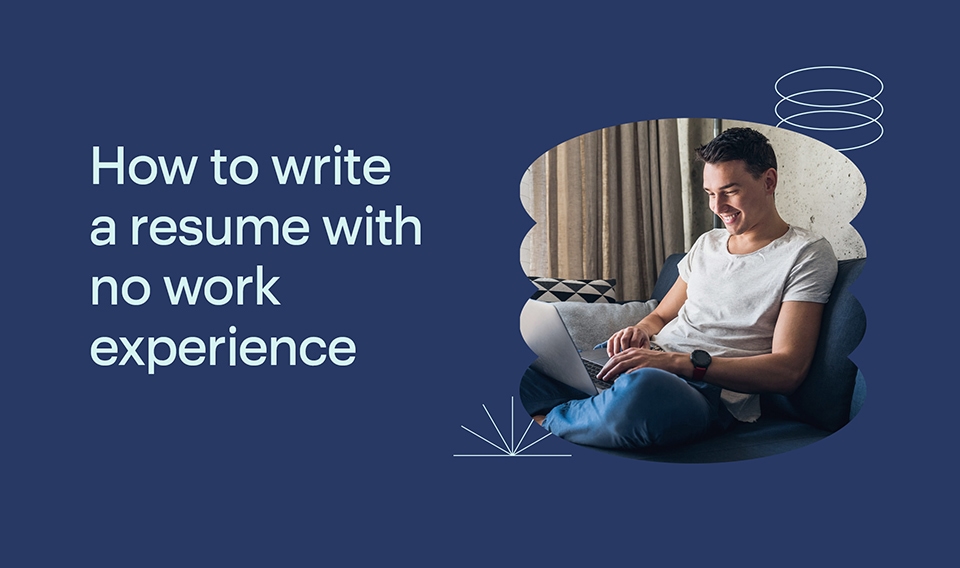
Writing your resume with no work experience can be tricky. You need to impress the hiring manager even if you have no relevant experience. When creating your first resume, focus on skills that are unique and valuable. Appropriate experience may include causal jobs, volunteering, or school activities.
Creating your first resume or applying to jobs without experience can be scary. How do you write a resume with no work experience? It may even be your first time having to write a resume, put eye-catching resume objectives, list your job skills , or choose a resume format. But at the end of the day, there is a first for everything, and hiring managers know it.
Do you want to save time and create your resume in just a few minutes? Try our premade Microsoft Word resume templates that will help you save time on designing and formatting so you can focus on highlighting your skills and expertise.
How to write a resume with no experience (with examples)
1. identify your goals for writing a resume with no experience, 2. choose a suitable resume format for a no-experience resume, 3. write a strong resume objective.
- > The objective for the resume with no experience examples:
- > Resume Objective for Students with No Experience
4. Create your education section
5. list your relevant experience , 6. highlight your skills on a resume with no work experience, 7. include your volunteer work .
- > Volunteer work on resume with no experience examples:
8. Tailor your resume for each position even with no experience
9. write and attach a strong cover letter , sample resume with no work experience.
There are several steps you should take before starting to write your resume . One of the most important ones is identifying your career objectives and finding the positions and industries you want to apply for. This is crucial to success because it will help you determine what aspects of your skillset and experience to focus on and what to highlight.
No matter how good of a fit you might be, you won’t see much success if your resume doesn’t stand out. So, remember that your resume should show that you can bring value to the company and are knowledgeable about the position. To achieve this, it’s vital to find out what your potential employer is seeking in an employee in two easy steps:
- Begin researching the job listings that align with your career goals and interests.
- Take note of and write down the keywords that appear repeatedly. These may be requirements, certifications, or skills that most of the job descriptions mention. You will want to include these throughout your resume to truly stand out.
Writing a resume with no work experience can be nerve-wracking, especially if it’s the first time writing a resume altogether. To get started, remember that a resume should always include the following five sections:
- A header with your name, job title, and contact details
- A resume summary/objective that presents your skills and achievements in a short paragraph
- An education section with the degree(s) or diploma(s) you have earned
- Your work experience, which can include even volunteering or similar experiences
- A skills section that summarizes all of your best abilities and talents that are relevant to the job
For a resume with no experience, you can also include extra sections for your hobbies, language skills, or academic projects.
But what’s the best way to organize these sections? That depends on the resume format you choose. There are three popular resume formats: functional, chronological, and hybrid. The functional format highlights skills and achievements and focuses less on work experience. On the other hand, a chronological resume format lists the work experience in reverse chronological order.
Finally, a hybrid format combines the other two, illustrating work experience and skills. While many employers prefer a chronological format, the other two are often better for resumes with no work experience. This way, hiring managers will see your achievements and skills immediately. Whichever format you decide to use, make sure to stick with it throughout your resume.
Read more: “What’s the Best Resume Format for 2024? [Pros vs Cons]
A resume objective is a brief introductory statement that describes your professional goals. Unlike a resume summary , a resume objective is suitable for a resume with no experience because it focuses on the value you could bring in the future. On the other hand, a resume summary presents existing achievements and expertise.
Most of the time, the recruiting manager is flooded with resumes. Thus, they only have a few seconds to scan each one. This paragraph is your opportunity to grab their attention and convey your abilities.
A resume objective should be no longer than three to four sentences and include the following information:
- Your field of study and highest education
- The skills and experiences that are relevant to the position
- Your motivation for applying to this particular position
Just like with contact information, you don’t need to give your resume objective a separate heading. Instead, you can place it under your header.
Example #1: Resume objective for freshers:
Example #2: resume objective for students with no experience.
Read more: “Resume Objective Examples for 2024 [+How-to Guide]
In your education section, show the degrees, training, and certifications that align with your professional goals without appearing over-or under-educated.
To do this, begin by documenting your educational and training background. This should be just an outline of what you’ve collected, so don’t stress about it not being amazing yet.
What should your education section include?
- Degrees and certifications earned
- Name of the degree
- Name of the college, university, or training school
- Years attended
- Optionally, you may also include:
- GPA if it is 3.40 or above
- Specific relevant coursework
- Exchange studies
- Extracurricular interests and online education/training
Creating your experience section may seem daunting since you most likely lack formal work experience. However, you still have much to include in this resume section, even with no work experience. Depending on your background, you can include:
- Academic projects – The easiest experience to include is academic projects. Whether it’s software you made in a programming class, a marketing campaign, or a website you created, they’re all experiences that show you have the skills to succeed. Overall, this is an excellent opportunity to add value to your resume without experience if you are a high school or college student. You can also include interests and hobbies if they relate to the work and have provided you with transferable skills. Extracurricular activities prove you’re dedicated and driven, so don’t be afraid to include them!
- Internships – Next, paid and unpaid college internships are one of the best weapons you have against the phrase “experience necessary.” They provide real-world work experience and help you network and develop contacts that may lead to a career later. So if you’re a college student writing a resume with no experience, include any internships you have undertaken.
To include an internship on your resume, first, write the title and function of your internship. Instead of simply “Intern,” use “Sales Intern” if your internship was in the sales department. Then, write down the name of the firm, the location, and the length of the internship – in that order. After that, provide a bulleted outline of your intern tasks and achievements. Finally, tailor your duties and accomplishments to the position you’re applying for.
Work experience example:
Marketing Internship YXPic, LLC. Miami, FL 2017 – 2019
- Managed firm social media accounts.
- Analyzing different social media outlets for viral content.
- Posted engaging content on the company’s Facebook page, which resulted in a 25% increase in customer interaction.
Lawn mowing and trimming Miami, FL 2015 – 2017
- From early spring until mid-fall, mow, edge, and trim lawns.
- Maintained seven lawns weekly throughout the season.
- Developed customer service skills to earn referrals and get more clients.
- In six months, I went from having 2 to having 10 clients.
- On lawn service, I earned and kept a five-star-rated page on Facebook
When creating your skills section, it’s crucial to focus on relevant, transferrable skills. The first step is to go through the job description and list the key required skills and qualifications you can meet. Employers value both soft and hard skills, so keep that in mind.
Team leadership, verbal communication, and self-management are soft skills that apply to every role. Hard skills , such as industry-related software or a foreign language, are gained through specialized education or training.
Because soft skills are harder to teach, most businesses focus on them when recruiting for entry-level employment. It’s okay if you haven’t yet developed all the hard skills required for a job. Nowadays, most companies will recognize your worth as a possible new employee if you prove to be a fast learner.
Still, make sure that you only include skills that are relevant to the position. For example, if you’re applying for an administrative assistant position, coding or trade skills won’t be very helpful.
Hard skills, soft skills examples:
Hard skills: Microsoft Excel , Cloud Computing , CRM Systems , Email management , POS Software , Programming Languages , Customer service , SEO
Soft skills: Interpersonal Skills , Collaboration , Problem-solving , Communication , Time management , Adaptability , Organizational skills , Active listening
Read more: 30 Top Skills for a Resume (With Examples)
Volunteering demonstrates your commitment and desire to put your skills to use. And nothing makes a recruiter happier than a dedicated employee. You may include it on your resume whether you volunteered at a soup kitchen or helped gather rubbish in the countryside. Most employers consider volunteer experience alongside paid professional experience. Thus, you should always aim to include volunteer work that displays your abilities or where you learned a new relevant skill on your resume.
Volunteer work should be stated in the same way as your employment experience section on your resume. So mention the organization’s name, location, the time you worked there, and a bulleted description of your responsibilities.
Volunteer work on resume with no experience examples:
Freelancing & Volunteering Phoenix, AZ 2017 – 2019
- Designed posters and created a Facebook page to assist a local community in promoting a series of garage sales events.
- Wrote promotional pieces and 20+ professional product evaluations for a small technology website.
- Converted a family member into an Apple customer by convincing him of the benefits of iOS over Android-based on his needs.
- Supervised a team of two regular news and content writers for a musical band’s fan site mentioned in a local newspaper.
- Planned and led games and activities for groups of elementary school students.
- Completed a course on the basics of efficient marketing on Udemy.
Nursing Volunteering Experience American Pulmonary Disease Association 2018 – 2018
- Provided patient education to 8 patients weekly.
- Performed an average of 13 health checks per week.
- Received praise from facility management for outstanding patient contact.
- Oversaw physical therapy sessions for 5 patients bi-weekly.
Customizing your resume for each position you apply for is the last and most essential aspect of developing a strong resume. If you lack experience, your greatest chance of landing an interview is to tailor your resume to the position you seek. Examine their job description to determine the skills they require. Then, take the skills you possess from the list and add them to your skills area. Different job advertisements will include different keywords, work responsibilities, etc. Adapting your application to each employer’s demands and job requirements is the best way to get your application noticed.
Most businesses utilize an applicant tracking system (ATS) to screen and organize resumes. So, when applying for any job, you must include a list of keywords on your resume to combat this. The best place to find these is in the job listing itself or in advertisements for related positions.
About half of applicants include a cover letter with their job application. So even with the lack of professional experience on your resume, you can increase your chances of success by preparing a strong cover letter.
A cover letter is a one-page letter sent with your resume as part of your application. Essentially, your resume describes your experiences, while your cover letter explains how they relate to the position. Here are the steps you need to take to compose an outstanding cover letter:
- Ensure that the format of your cover letter adheres to all professional correspondence formatting requirements.
- Create an engaging introduction to your cover letter that presents you to the readers and motivates them to continue reading.
- Describe your skills and how they may assist the organization.
- Explain why your cultural fit is exceptional.
- Always include a call to action at the end of your cover letter.
Also, ensure that your cover letter is the appropriate length. As with the rest of your resume, your cover letter should be relevant, simple, and brief.
Read more: How to Write a Great Cover Letter in 6 Steps
Example of a resume with no work experience
Sarah Brown 58 South St, Phoenix, AR [email protected] (123) 456-7890
An independent and driven business administration student with demonstrable proficiency in business, procurement, sales, and marketing. I am eager to use my theoretical knowledge and introduce the most current industry standards to the company.
EDUCATION Phoenix High School Phoenix, AR Class of 2020 (3.9 GPA)
EXPERIENCE Sales Intern ABC Company 2021-Present
- Assisted the sales regional sales manager in ad hoc tasks.
- Took notes and shared them with attendees at weekly team meetings.
- Prepared monthly reports for 7 international clients.
- Uncovered a bookkeeping error, saving the department 5% of yearly expenses.
Soup Kitchen Volunteer Phoenix, AR 2020 – 2021
- Acted as weekend/holiday volunteer manager at a local soup kitchen.
- Organized volunteer shifts and monitored the input of donated food.
- Aided with preparing and delivering meals on Sundays and major holidays, including Thanksgiving, Christmas, and Easter.
Pet Sitter Phoenix, AR 2018-2020
- Established and operated a profitable pet sitting service.
- Offered services including dog walking, feeding, and yard maintenance to locals in a 5-mile radius.
- Acquired and maintained 13 clients, arranged and attended visits, coordinated appointments, and managed client relationships.
- Collaboration
- Bookkeeping
- Attention to detail
- Microsoft Office
AWARDS & ACHIEVEMENTS
- National BA Honor Society
- Volunteer Club President and Treasurer of the Phoenix High Cheerleading team
Writing your first resume can be daunting, especially if you have no work experience. So, get ready to edit and tweak your resume until you get the desired results. Using these simple tips, you will create a resume demonstrating your strengths and getting you noticed. This is your chance to show prospective employers how you’ve prepared for the job and why employing you would benefit their company.
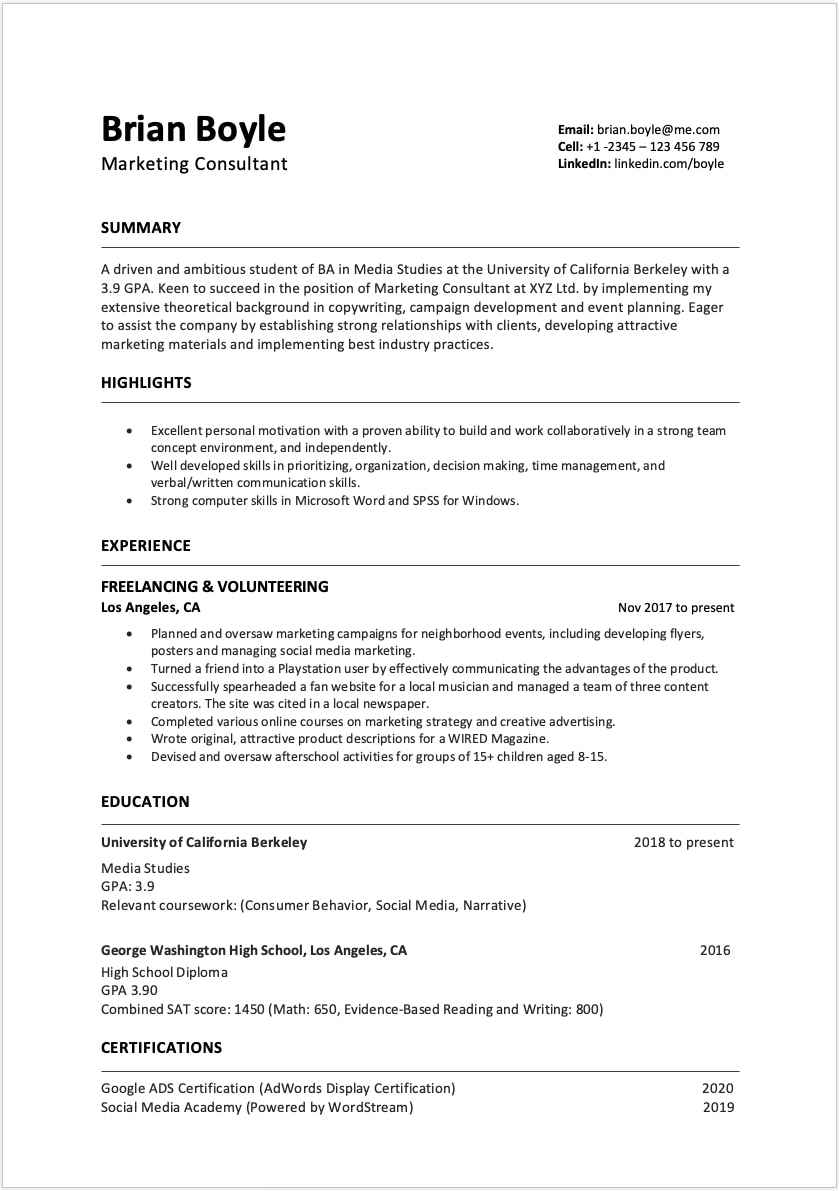
Popular related posts:
- 15 Best Skills for a Resume (With Examples)
- Thank You Email After Interview: Examples, Dos, and Don’ts
- 7 Ways to Improve Your Cover Letter Today
- Resume Objective Examples for 2024 [+How-to Guide]
- Cover Letter Format: A Step by Step Guide for 2024
- How To Write a Cover Letter With No Experience in 9 Steps
Get Expert Resume Writing Help
No time to polish your resume and cover letter? Send it to our team of resume writing experts.
- No products in the cart.
- Resume Writing Service
- Free Resume Review
- Resume Templates
- Career Advice
How to Write a Resume with No Experience [21+ Examples]

It’s time for your first job hunt !
You need to write a resume , which can be nerve-wracking if you don’t have any real-life work experience.
You don’t know where to start, what to include, or which resume format to choose.
On top of that, most advice you find online isn’t relevant because it focuses on emphasizing professional background.
Chances are, you’re straight out of college with no experience to speak of.
Or maybe you're a high-school student applying for a part-time job.
Whichever the case may be, you’re probably having trouble filling in the blank space on your resume that’s supposed to be the work experience section.
Worry not, though. In this guide, we’re going to help you create an AMAZING resume, no work experience is needed.
- How to format your resume with no work experience
- 4 sections to replace work experience (that help you stand out)
- 2 no-work experience resume samples (guaranteed to land you the job)
How to Format Your Resume [with No Work Experience + Examples]
A resume format is the layout of your resume .
The ideal resume format usually depends on how much work experience you have.
But what happens when you have none?
For a no-experience resume, we recommend that you use the reverse-chronological format .

It’s the most popular format amongst applicants and a recruiter favorite.
The sections in your reverse-chronological resume will be:
- Header : Contact Information and Resume Statement
- Internships, extracurricular activities, projects, volunteer work (These sections will replace your work experience)
In this article, we’ll walk you through each of these sections, and explain how to write them in a way that you stand out from the crowd.
Let’s dive in.
Start With Your Resume Header

Your resume header includes your contact information and your resume statement.
Below, we’ll show you how to write both of these elements and how to include them in your header section.
Put Down Your Contact Information
Just like the name suggests, the first thing you add to your header is your personal and contact information.
It’s the easiest part to get right, just keep it short and to the point.
In your contact information section, mention the following:
- First and Last Name
- Phone Number
- E-mail Address
- A link to a professional profile (e.g. LinkedIn ) or personal webpage (if you have one)
Make sure to use a professional-sounding E-mail.
I.e. something along the lines of “[email protected].”
You’re sure to leave a wrong impression if you use an email you created back in preschool ( “[email protected]” ).
Make sure to double-check, triple-check your contact information. After all, the recruiter can’t contact you if you have a typo in your phone number.
(Optional) Write Your Resume Objective
A resume objective is a short heading statement in your resume, where you describe your professional goals and aspirations.
Fun fact - hiring managers look at your resume for 5-6 seconds max .
Yep, that’s right. In most cases, the hiring manager is literally drowning in resumes. So, they have a couple of seconds to skim each one.
Well, this section is your chance to catch their attention (and let them know you’ve got what it takes).
A resume objective is usually 3-4 sentences max and includes information on:
- What your field of study is;
- What your skills and experiences are (ones that are relevant to the job );
- Why you’re applying for this position and/or this company.
As with contact information, you don’t need to label your resume objective with a title. Just write it underneath your contact information section.
Here’s an example of what a resume objective looks like:
“ Recent Communications graduate looking to apply for the role of Secretary at XYZ inc. Extremely organized with good writing and multitasking skills. Practical experience in management gained through several university projects, which involved coordinating tasks between different team members and ensuring that everyone was in sync with the latest information. ”
Emphasize Your Education

In your average resume, the first section would be work experience.
Since you don’t have any, though, you’ll want to omit that and replace it with the education section.
This way, you bring a lot more attention to your education, which is one of your main selling points.
What should you include in the Education section?
List the following features in this order:
- Name of the degree
- Name of the institution
- Years attended
- Location of the institution (optional)
- GPA (optional)
- Honors (optional)
- Relevant coursework (optional)
- Exchange programs (optional)
As a general rule, if you studied in a prestigious university, you can add the name of the institution before the degree . This way, you will catch the recruiter’s attention faster.
Now, let’s go through some real-life examples:
BA in Computer Science
Tufts University
Medford and Somerville, Massachusetts
10/2015 - 06/2018
Magna Cum Laude
- Exchange Program in Greenville, NY
University of the Arts London
BA in Interior Design
10/2017 - Ongoing
Westwood High
Boston, Massachusetts
Class of 2018

Education Section Q&A
Still have some questions about the education section? Worry not, we’re about to give you all the answers!
Do I include my GPA?
- The answer here is a “maybe.” We’d recommend including a GPA if it’s higher than 3.5. Anything lower than that, and you might be underselling yourself. Keep in mind, though, that most employers don’t care about your grades.
Should I include my coursework?
- Yep, but just as long as it’s relevant. If you have no work experience, including courses can help establish your expertise in a field. Feel free to skip out on any basic courses, though. No one cares about your Maths 101 course.
Do I mention my degree if I dropped out?
- If you studied for more than 2-3 years, yes. A half-finished degree is still better than no degree. If you dropped out after a semester, though, that doesn’t really mean much.
Do I mention my high school degree?
- Only if it’s your only degree. If you have any higher education, your high school degree will only take up space.
4 Sections to Replace Work Experience [With Examples]
Now that you’ve listed your education, it’s time to fill that work experience gap in your resume.
You aren’t still worried about your lack of experience, right?
Because here are four sections you can use instead:
1) Internships
Have you done an internship that is relevant to the position you are applying for?
Now’s the time to mention it.
Here is how you add an internship to your resume:
First , place the Internship section right after the education section.
Title it: Internships
Second , write your internship title and role . Be specific.
If your internship was in the marketing department, instead of just “Intern”, say “Marketing Intern”.
Third , put down the company name , location , and duration of the internship - in that order.
Marketing Intern
Full Picture
New York, NY
09/2019 - 12/2019
Easy and straightforward, right?
One more step:
Last , add a list of responsibilities you had as an intern in bullet point form.
If you have any tangible achievements , even better! Write those in as well.
Finally, tailor both the responsibilities and achievements to the role you’re applying for.
Here’s how that looks in practice:
You used to be an Advertising Intern .
You’re applying for the position of Social Media Assistant .
Here’s how you would put down your internship entry:
Internships
Full Picture Company
- Analyzed various social media platforms for trending content
- Managed company social media accounts
- Posted interested content on company Facebook page, increasing engagement by 25%
The listed responsibilities and achievements are directly connected to the Social Media Assistant job requirements.
You’re applying for a Content Writer position. Take a look at the same entry now:
- Assisted the Marketing Manager in writing press releases and new blog posts , which increased web traffic by 25%.
Notice how the internship title remains the same.
But in this case you’re applying for a Content Writer position, so you are highlighting your writing experience instead.
For more examples, check out our full guides to an internship resume and how to write a cover letter for an internship .
2) Extracurricular activities
Still have a ton of empty space in your resume?
Extracurricular activities are always a great addition!
Whether they’re related to the job you’re applying for or not, they still show one thing:
You’re hard-working and motivated.
Imagine you’re the HR manager, and you can pick between these 2 candidates:
- Josh Johnson. Studied at Massachusetts State. 4.0 GPA, but that’s all he did in college - no extracurricular activities, internships, or anything else.
- Suzie Activeson. Also studied at Massachusetts state. 3.2 GPA. Vice-president of the business club. Served as a student government senator for 2 semesters. Organized several events as part of the marketing club.
Sure, Josh is probably qualified, but we don't know anything about him, other than that he studied a lot.
Suzie, on the other hand, can manage a team (business club VP), organize events (marketing club), and is passionate about making a change (student government).
So, which one would you pick?
Now, let’s explain how to list extracurricular activities on your resume:
- Title of the section: Extracurricular Activities
- Name of the organization and/or team
- Your role in the organization
- Time period
- Noteworthy awards or achievements
Extracurricular Activities
Public Speaking Club
Vice-President
09/2018 - 09/2019
- Organized 10+ public speaking lectures
- Brought in speakers from all over the state
- Conducted public speaking workshops
3) Volunteering Experience
Volunteering shows dedication and passion to apply yourself.
And there’s nothing recruiters love more than a committed employee.
Whether you spend your free time in a soup kitchen, or you helped collect trash in the countryside, you can mention it in your resume!
But how do you list volunteering experience?
Well, it follows the same logic as your internship and extracurriculars:
- Title of the section: Volunteering Experience
- Name of the organization
- Relevant tasks and achievements (bullet points)
Volunteering Experience
Grand Archive Library Volunteer
Washington, D.C
08/2017 - 02/2019
- Performed secretarial activities, such as sorting mail, filing documents, answering phone calls, and taking messages.
- Led a poetry reading event twice a month.
4) Projects
In this section, you can add any relevant projects you were part of during your time in school or at an internship.
Your capstone project, graduation thesis, or research project go here.
No need for work experience!
You can also mention any other type of project you’ve worked on in school, including:
- Business project for a real-life client
- Mock website you created in Web Design 101
- Fake magazine you created as a capstone project
- Market research you did as part of your graduation thesis
- Software you developed in Software Engineering class
...And so on!
Here’s how you put them down:
- Title of the section: Projects
- Project name
- Project type
- Related organization
- Relevant responsibilities and achievements (optional)
And now, for some practical examples. Here’s what a journalism student project could look like:
Online Privacy and Social Media: a Journalistic Study of Facebook and Cambridge Analytica
Journalism Capstone Project
Harvard University
09/2018 - 11/2018
And here’s a law school example:
In-House Pro Bono Project
Columbia Law School
11/2018 - 03/2019
- Completed a full petition for U nonimmigrant status, interviewed legal persons and drafted affidavits.
If you have anything physical to back up your project with, feel free to include a link.
For example, if you’re a developer, you could include a link to your GitHub profile.
Stand out with your Skills

There are two types of skills you can include on your no-experience resume:
Soft skills and hard skills.
What’s the difference?
Soft skills are attributes or habits that describe how you work. They are not specific to a job, but indirectly help you adapt to the work environment.
Here are some of the most popular ones: teamwork, responsibility, leadership, creativity, etc.
Hard skills , on the other hand, refer to specific tools, technical knowledge and training and other work-specific skills. They apply directly to the job.
Technical writing, C++, financial accounting, etc. are all examples of hard skills.
So, which of these skills should you include?
That depends on a lot of factors, but as someone with no work experience, you should opt more for hard skills .
See, you could write all the cool buzzwords like “Critical Thinking” and “Leadership,” but the recruiter won’t believe you.
Fun fact - that’s what 90% of students do.
Instead, you should focus on skills that make you stand out , and in most cases, those are hard skills.
So, how do you decide which hard skills to mention? Easy! Just check the job ad you’re applying for.
Let’s say you’re applying for an entry-level creative internship, and you find these requirements in the job description:
- Video editing experience (Premiere, After Effects)
- UI design experience
- Photo editing experience (Photoshop)
- Photography experience
- Experience with Adobe Illustrator
You’d transfer this into your skills section:
- Premiere & After Effects - Expert
- Photoshop - Expert
- UI Design - Intermediate
- Adobe Illustrator - Intermediate
- Photography - Intermediate
Not sure which skills to mention? Check out our article on 150+ must-have skills for all sorts of professions !
Other Sections You Could Include in a No-Experience Resume
A resume without experience does have one advantage: extra space .
You can use this space to create other sections that highlight how awesome you are!
Here are some sections you could include:
- Hobbies and Interests . Add flair to your resume by showing your genuine passion and interest in the industry.
- Languages. Do you know a second language? Or even a third? Awesome! Most companies these days are pretty international and appreciate an extra language skill or two. Be mindful not to over-exaggerate your proficiency, though. Only knowing how to ask “¿Donde está la biblioteca?” doesn’t warrant a Spanish entry on your resume.
- Awards & Certifications . Do you have any fancy pieces of paper that show you’re smart? Maybe it’s an award for a terrific essay in a competition, or a certificate from an online course . Whichever the case may be, awards and certifications show that you’re a winner, so definitely include them in their own respective section.
Need Inspiration? 2 No Work Experience Resume Samples
Do you still have questions or don’t know where to begin?
That’s when a resume sample comes in handy.
It provides you with a predetermined format.
It also helps you picture how your no-experience resume is supposed to look like.
As Picasso put it: Good artists copy; great artists steal!
Here are 2 no work experience resume samples you can borrow ideas from:
Business Student Resume Sample
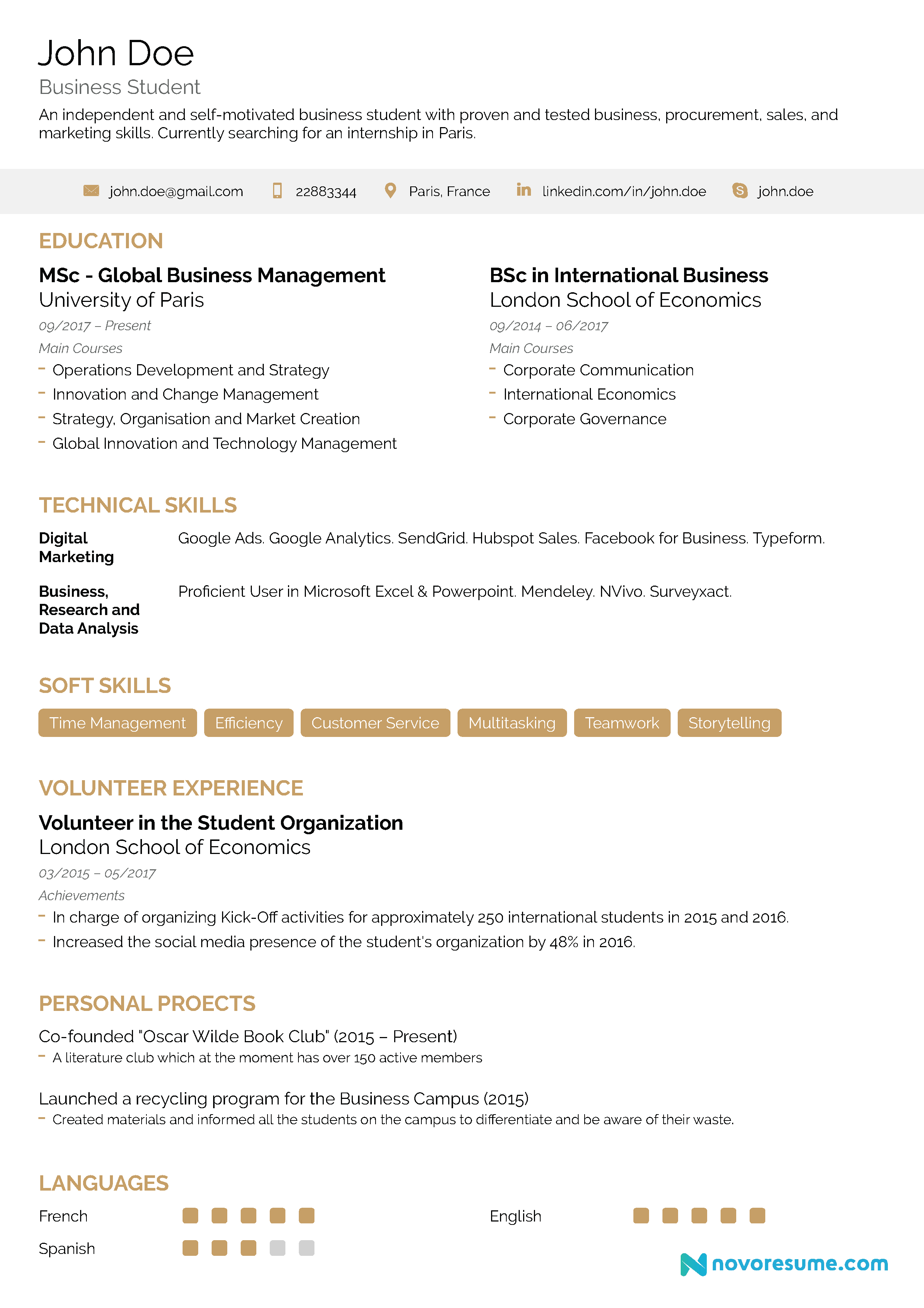
High-school Student Resume Sample
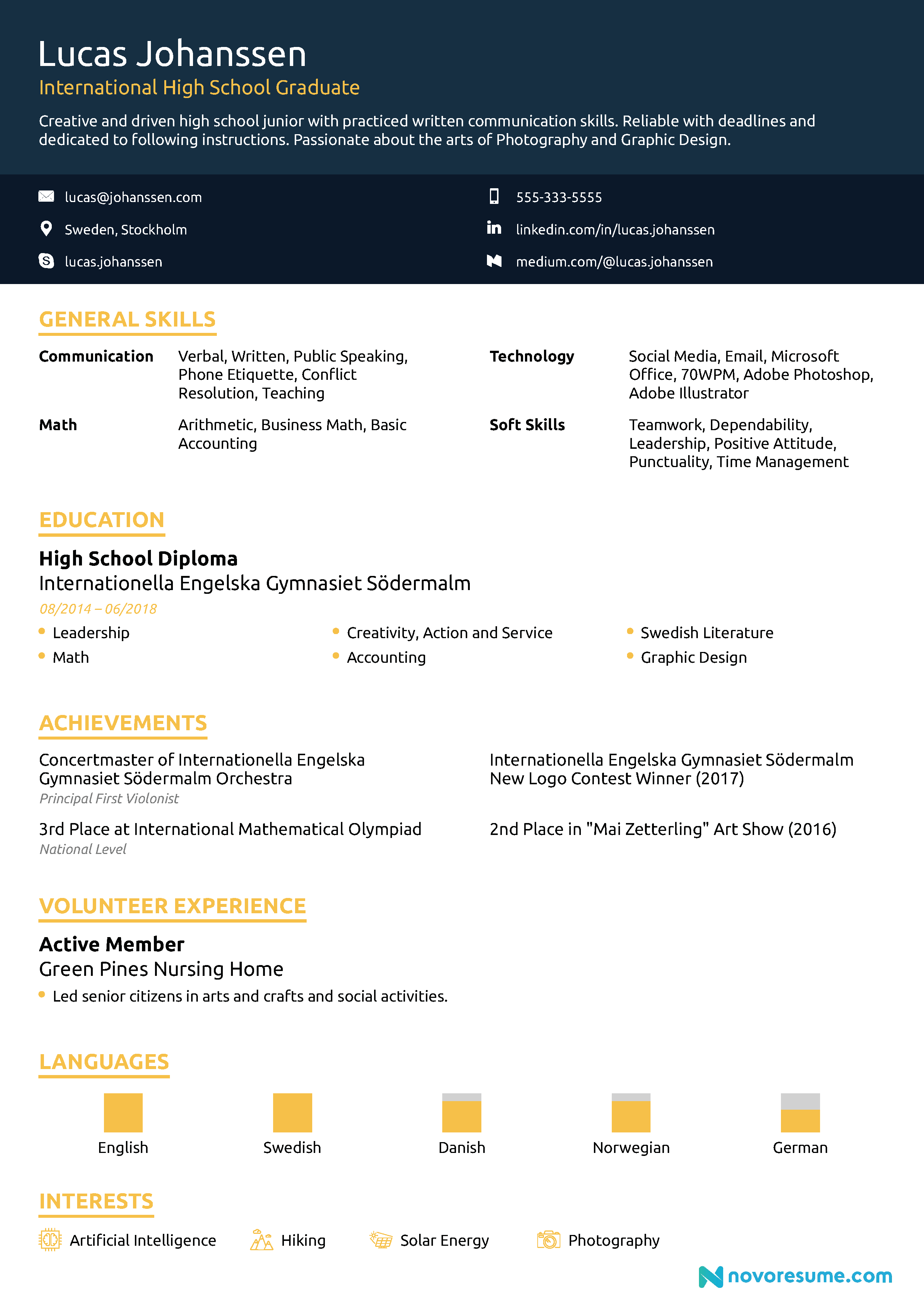
Create a Matching Cover Letter
All done with your resume?
It’s not over yet. You need to write a cover letter to go with it.
A cover letter is a single-page letter that accompanies your resume and is part of your job application.
Look at it this way: your resume describes your experiences, and your cover letter explains (in simple words) how they’re relevant to the job.
Now, here’s a quick infographic on what to include in a cover letter:

Finally, as with everything else in your resume, make sure to keep your cover letter relevant, short, and concise.
The hiring manager doesn’t have time to read an autobiography, they’ll only review your cover letter for a few minutes.
There’s a lot more to creating a good cover letter than what we just explained.
For a complete, all-you-need-to-know walk-through, check out our Complete Guide on How to Write a Cover Letter !
Key Takeaways
...and that’s a wrap!
At this point, you should know everything there is to know about writing a killer no-experience resume.
Just to keep things fresh, though, let’s quickly go through everything we’ve learned so far:
- When creating your no-experience resume, use the reverse-chronological format.
- You can create a killer no-experience resume by emphasizing your education instead. Include relevant internships, soft & hard skills, and projects.
- Other sections you can include on your resume are hobbies & interests, languages, certifications, or achievements.
- Keep all the content on your resume clear, precise, and relevant. Use bullet points for all your descriptions.
- After you’re done with your resume, you want to write an awesome cover letter that goes with it. The cover letter is a one-page letter that tells the story behind your resume content and reemphasizes why you’re a great fit for the job.
Related Resume Examples
- Internship Resume
- High School Resume
- Research Assistant Resume
- College Resume
- Students and Graduates Resume
- Teacher Resume
Recommended Readings:
- 43+ Resume Tips and Tricks to Land Your Next Job in 2024
- 20+ One-Page Resume Templates [Free Download]
- 35+ Common Interview Questions and Answers [Complete List]

To provide a safer experience, the best content and great communication, we use cookies. Learn how we use them for non-authenticated users.
- Resume Tips
Writing an Outstanding Resume with No Experience (+ Examples)

It might seem like an uphill struggle, or something that’s impossible to achieve. A resume with no work experience? After all, the whole point of a resume is that it’s all about showcasing your work experience and career progression–isn’t it?
Well, yes–your resume is usually a succinct history of your career, skills, and qualifications.
But we all have to start somewhere in the world of work. We don’t want to have a Catch 22 scenario where you can’t get a job because you haven’t got any experience, and you haven’t got any experience because you can’t get a job!
So, don’t worry; help is at hand. Crafting a resume with no experience is not as daft as it sounds. It can certainly be done, and in such a way that means you’ll be snapped up in no time, if you follow ZipJob’s guidelines when applying for entry-level roles.
What can I put on my resume if I have no work experience?
It’s a real conundrum. How to fill a page with relevant information when you’re barely out of shorts, and certainly have no idea where to start?
We’ve got you covered, with a list of sections and the sort of information to include on your resume with no work experience.
The best way to start is by splitting the page up into different areas, and concentrating on each… one at a time.
Summary for a resume with no experience
The Professional Profile is the first bit of writing that a hiring manager will read, positioned just underneath your contact details. Try to avoid cliches and buzzwords . Instead, emphasize your transferable skills and what you can offer the organization, in a paragraph format, three or four sentences long.
Skills section
Underneath is the skills section. As you have little or no experience, chances are you’ll need to focus on soft skills here, such as polished communication, organization, time management, and decision-making. If possible, use examples of when you have used these to great effect within your resume with no work experience.
Education section
If you’ve graduated within the last year or two, your education section should come next since it’s the most recent thing you’ve achieved. Detail out your GPA if it’s high and include modules covered, with percentages of any exams taken.
If you achieved any extracurricular accolades while at college or university, include those as well.

Volunteer work section
There are many fabulous skills you can glean from volunteer work –from teamwork to collaboration and project management, so really go to town here with blowing your own trumpet.
Additional sections
This is the place where you can add anything else that hasn’t already been covered, such as relevant hobbies and interests , societies that you belong to, language ability, or internships.
Can ChatGPT build resumes?
One last word of advice, and it’s about ChatGPT . While it might be really tempting to let this AI tool do the work for you, resist! It has limited responses to any prompts, and will just splurge out generic fluff, without a thought for your individual achievements.
Craft your own resume, using ZipJob guidelines, and by looking at the three examples for inspiration.
First time resume with no experience samples
Check out our examples of resumes with no experience below.
1. This first one is an undergraduate looking for his first foray into the world of work. His resume is angled towards becoming an Actuary. Note how he focuses all his achievements and accolades towards this goal, detailing Math awards and other relevant skills. His core skills section is a bit further down the resume with no work experience, as relevant information and achievements are considered more relevant in this case.
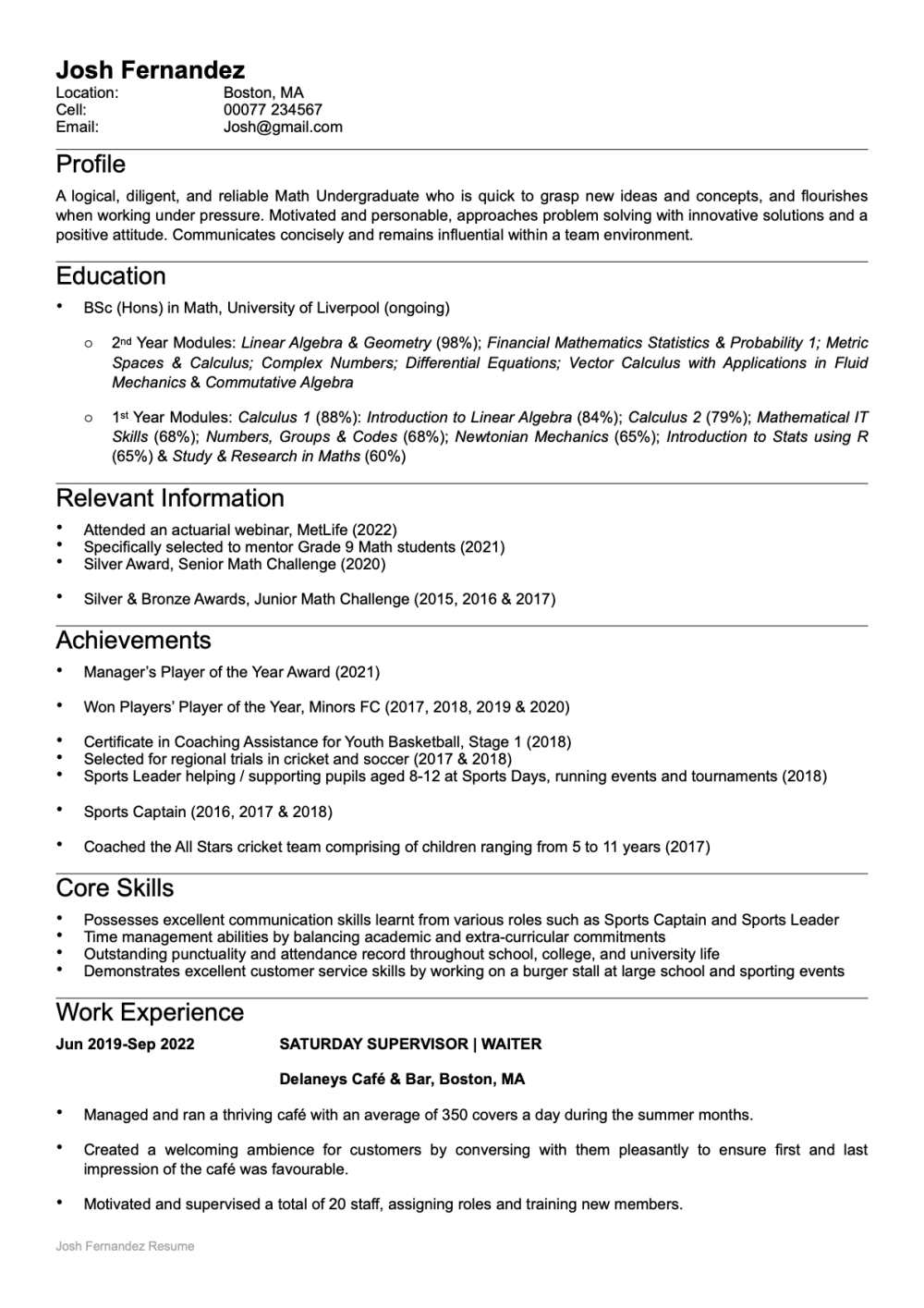
2. The second example is a client with literally no work history at all, having spent all her precious time bringing up her family. She has opted to use first person for a more informal approach. See how she details out her skills, learned from being a homemaker, as well as emphasizing many transferable soft skills that should give her traction to land a role as a cleaner, which is her aim.
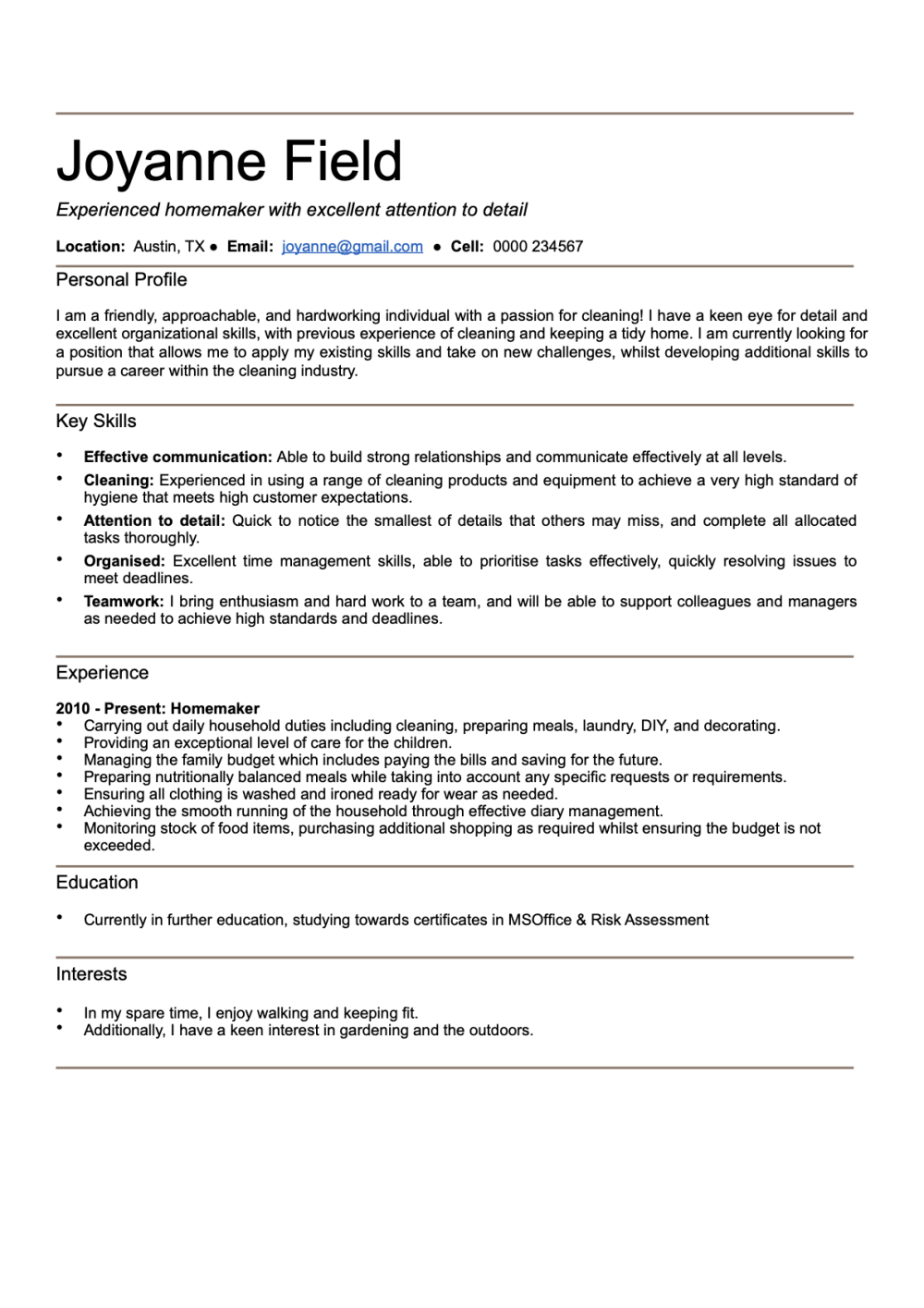
3. Our final example is a school leaver, looking to enter the environmental sector by showcasing relevant volunteer work and further attributes. Here, the skills matrix, relevant information, and a voluntary post are the focus.
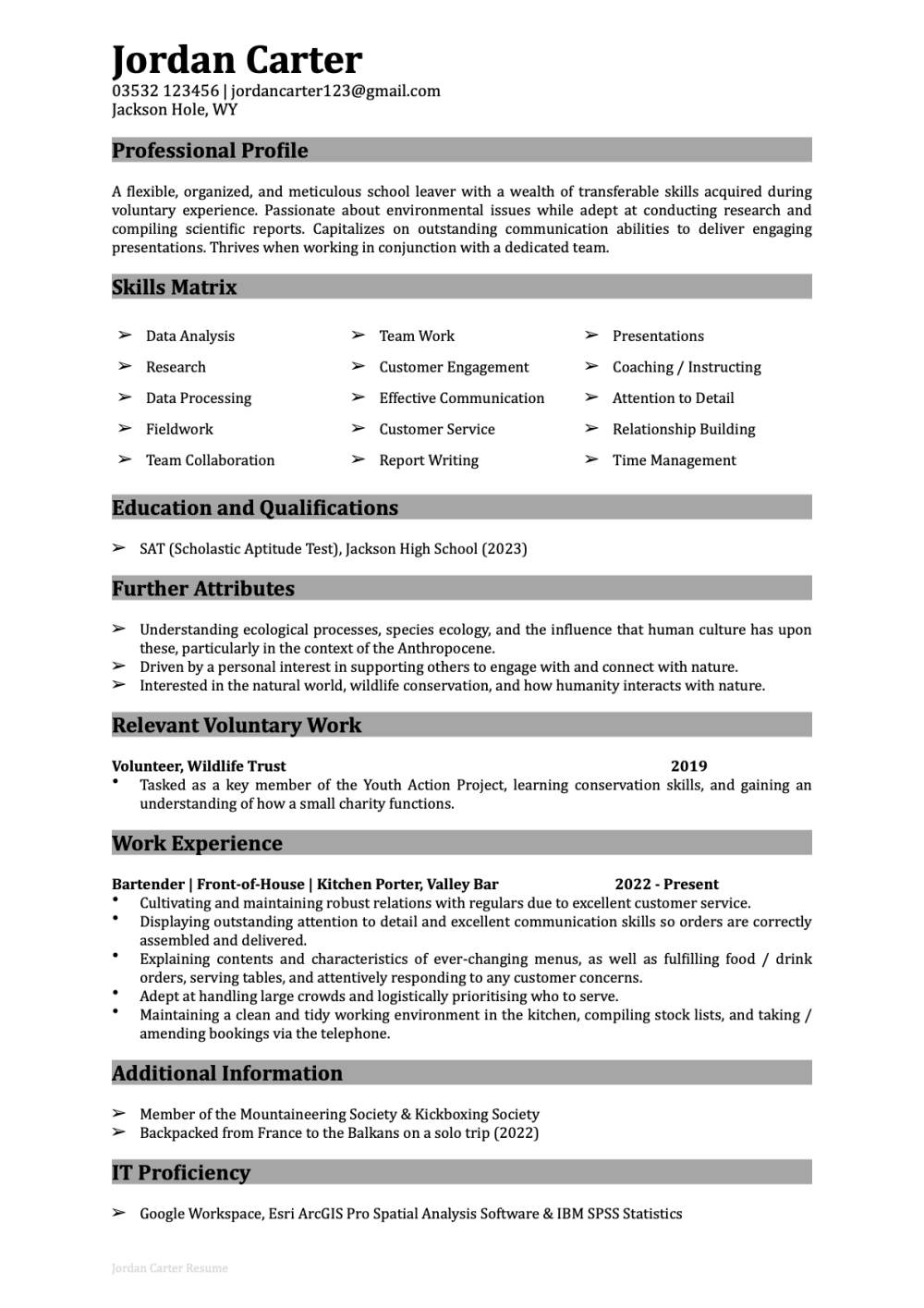
Writing a resume with no experience can be a daunting task to tackle on your own. Check out what ZipJob’s professional resume writers can do for you.
Recommended reading:
99+ Essential Keywords and Phrases for Impactful Resumes
10 Best College Grad Job Search Sites (Updated for 2024)
19 Essential Skills for Resumes: Examples Included
Elizabeth Openshaw, Editor & Content Writer, Elizabeth Openshaw, Editor & Content Writer
Elizabeth Openshaw is an Elite CV Consultant with over 12 years of experience based in Brighton, UK, with an English degree and an addiction to Wordle! She is a former Journalist of 17 years with the claim to fame that she interviewed three times Grand Slam winner and former World No.1 tennis player, Andy Murray, when he was just 14 years old. You can connect with her at Elizabeth Openshaw | LinkedIn .

Our resume services get results.
We’ve helped change over 30,000 careers.
Get a free resume review today
Our experts will review your resume’s grammar, layout, and ability to pass ATS — all free and delivered straight to your inbox.
PROTECT YOUR DATA
This site uses cookies and related technologies for site operation, and analytics as described in our Privacy Policy. You may choose to consent to our use of these technologies, reject non-essential technologies, or further manage your preferences.
- Search Search Please fill out this field.
- Career Planning
- Finding a Job
First Resume With No Work Experience Example
What to include on a resume when you don't have work experience
:max_bytes(150000):strip_icc():format(webp)/ADHeadshot-Cropped-b80e40469d5b4852a68f94ad69d6e8bd.jpg)
Writing Your First Resume
What to include in your resume.
- Tips Preparing Your First Resume
Resume Template and Example
More resume examples and templates.
YinYang / E+ / Getty Images
Writing your first-ever resume can be a challenge. How do you sell yourself to an employer when you’re a student who doesn’t have any experience in your targeted field?
When writing your first resume with no formal work experience, it's appropriate to include casual jobs like babysitting, pet sitting, lawn mowing, and shoveling snow. You can also include volunteering, internships, and school and community activities.
All experience counts, and the best way you present yourself, your skills, and your assets to a hiring manager is to provide them with a strong resume that showcases your own unique talents.
Here's how to write your first resume, what to include, how to show employers the skills you have, a sample resume to review, and a template you can use to get started writing your resume.
To get started, review information on the different parts of a resume and what is included in each element. It's a good idea to review high school resume examples to get an idea of what is appropriate. Even if you've never held a formal job, you still have important life experience that's applicable to the job search.
Don't forget to look at volunteer work, civic groups, and youth organizations (for example, the Scouts or 4-H). The skills you have developed doing these things have given you valuable experience that will impress employers.
The bottom line is that you actually have a lot more experience than you think you have.
Writing your first resume can seem intimidating, but if you take it step-by-step, you will be able to put together a document that will highlight your abilities and show the hiring manager that you’re worth calling for an interview.
Start by mining your life experience and academic achievements to show that you'll be an asset to the company, despite the fact that you don't have any related job titles to show off at this stage in your career.
For your first resume, take the soft skills (also known as “people skills”) you have and show how they translate into success where you choose to apply them. Include volunteer experience, school achievements, sports, clubs, and organizations you belong to.
Scan the job descriptions for the positions to which you're applying. Look for keywords that indicate what the hiring manager values in a candidate.
For example, the job listing might say, "Successful candidate will be a self-starter who delivers on time and on budget." In that case, despite the fact that you don't have relevant work experience in the same field, you can get the hiring manager's attention by being sure to include (and emphasize) projects that you've successfully led, such as high school clubs in which you held a leadership role that required you to manage both your time and the team's money.
Other “ people skills ” that employers often seek in entry-level job applicants include traits like dependability, good communication and organizational skills, a solid work ethic, and teamwork.
If you start with the job listings instead of with the blank page, the hiring manager's keywords will guide you, and help you focus on which of your academic or after-school experiences have prepared you for this first step in your career.
Once you've compiled a list of what you need in your resume, it should include:
- Contact information
- Experience (casual work, volunteering, clubs, youth organizations, teams)
- Skills (related to the job)
- Awards and Achievements (academic and extracurricular)
Tips Preparing Your First Resume
- Don't lie. No matter how tempting it might be to stretch the truth, lying on your resume is always a bad idea. You might make it through this round of interviews and even get the job, but you won't be able to deliver on the promises your resume offered. Plus, you'll probably be caught—and fired.
- Don't pad. You don't need to include the line "references upon request," or personal information beyond your contact information, or a bunch of unrelated hobbies. In fact, there's a lot of stuff you don't need to put on your resume , even when it's your first one.
- Proofread. Nothing is less persuasive than a resume full of typos and inconsistencies. Have a trusted friend or family member proofread your resume before you submit it.
Download the resume template (compatible with Google Docs and Word Online) to use as a starting point for your own resume.
Resume Example (Text Version)
Michelle Washington 18 Sunnyside Boulevard Arlington, NY 16543 mwashington@email.com 111.123.1234
EDUCATION Arlington High School, Arlington, NY CLASS OF 2022 (3.9 GPA)
Pet Sitter — Arlington, NY JUNE 2020 - PRESENT
Established and run successful pet sitting business including dog walking, feeding, and yard care. Responsible for obtaining clients, scheduling and attending visits, organizing visits, and maintaining client relationships.
Soup Kitchen Volunteer — Arlington, NY SEPTEMBER 2020 - PRESENT
Act as weekend/holiday volunteer manager at local soup kitchen, scheduling volunteer time slots, managing intake of donated food, and assisting with preparation and distribution of meals on Sundays and holidays including, Thanksgiving, Christmas, and Easter.
Child Care Provider — Arlington, NY JUNE 2018 – JUNE 2020
Provided child care for several families after school, on weekends, and during school vacations.
SKILLS
Customer service Hospitality Microsoft Office Google Drive
AWARDS & ACHIEVEMENTS
National Honor Society Honor Roll President of high school Volunteer Club MVP, Arlington Varsity softball team
Here are more examples that you can use to get ideas for your own resume:
- Entry-Level Resume Example
- High School Student Resume Example
- High School Student Resume Template
CareerOneStop. " Get Work Experience ."
CareerOneStop. " Resumes ."
- Top Courses
- Online Degrees
- Find your New Career
- Join for Free
How to Write a Resume with No Experience: 5 Tips
Writing a resume with no formal work experience means emphasizing other aspects of your life that’ll showcase your skills and passions—like your education, and involvement in activities like extracurriculars or volunteering.
![example of resume to apply job without experience [Featured image] A young man shows his resume with no experience to a hiring manager.](https://d3njjcbhbojbot.cloudfront.net/api/utilities/v1/imageproxy/https://images.ctfassets.net/wp1lcwdav1p1/7fTKVCoWKhwff9eSaQQ0P6/cfe6a0153ae1c56e02f15075595cf820/GettyImages-472097889__1_.jpg?w=1500&h=680&q=60&fit=fill&f=faces&fm=jpg&fl=progressive&auto=format%2Ccompress&dpr=1&w=1000)
Having dedicated sections for a summary and a list of skills can round out your resume.
Resume with no experience: Template
Templates can help you organize your thoughts, inspire you with ideas, and take the guesswork out of how to format your resume. And regardless of how much experience you have, starting a resume from scratch can be daunting.
Here’s a resume template you can use if you have no work experience .
Here’s the resume filled out below.

Read more: How to Get a Job with No Experience: A Job Seeker’s Guide
How to write a resume with no experience: 5 tips
If you have no experience you can point to in your resume, highlight your education, include relevant non-work experience, list your skills, and include a summary. Get started by using a template.
1. Highlight your education.
If you have little work experience, emphasizing your education is a great way to showcase your strengths, interests, and background.
Some items you’ll want to consider including in the education section of your resume are:
Relevant coursework: Be sure to list any courses that will emphasize skills that can be helpful for the job. These might include courses that focus on technical skills—like economics, math, or computer science. But don’t forget the importance of courses like English or writing that can show your competence in communication or other human skills. Look through job descriptions to see what kinds of skills are desirable for the field you’re interested in.
GPA and honors: A strong grade point average (GPA) can indicate a willingness to work hard and an aptitude for your field. Experts recommend listing your GPA if it’s at 3.5 or above [ 1 ]. If you’ve received any academic honors, it’s a good idea to list them, too.
Relevant projects: If you’ve completed projects in classes that are particularly relevant to the job you’re applying to, list and briefly describe them. If you have more than one, this can be its own section.
Certifications and online courses: If you’ve completed any coursework outside of school or received a professional credential, list these under the education section as well.

Build job-ready skills with a Coursera Plus subscription
- Get access to 7,000+ learning programs from world-class universities and companies, including Google, Yale, Salesforce, and more
- Try different courses and find your best fit at no additional cost
- Earn certificates for learning programs you complete
- A subscription price of $59/month, cancel anytime
2. Include relevant experience.
When you first start putting together a resume, you might feel like you don’t have any relevant experience to refer to. But a little digging into your life could unearth several experiences that show your professionalism, interests, and character—all things a potential employer can consider important.
You can include the following in a section titled “Relevant Experience”:
Volunteer experience: Volunteering demonstrates your community involvement, ability and willingness to work with others, and your interests. It might even have gained you some hands-on experience in a related field.
Part-time jobs: Maybe you worked part-time while you were in school, tutored or babysat kids, or helped your parents out at their small business. If you’re applying for your first full-time job, don’t shy away from including these. Part-time jobs can demonstrate your employability and experience with key skills like customer service.
Extracurricular activities: Whether you played sports, were part of a cultural club, or participated in student council, extracurricular activities can help show a willingness to explore your interests, develop new skills, and work on a team. Don’t forget to include any leadership positions you might have held in these activities.
3. List your skills.
Chances are even if you don’t have any formal work experience, you probably have skills that will be useful in the field. Look through several job descriptions of positions you’re interested in to see what skills are commonly requested.
The relevant skills you’ll choose to list will likely depend on the job, but might include:
Microsoft Office products like Word, Excel, or PowerPoint
Communication
Computer programming
Social media
Foreign languages
Public speaking
Customer service
Not sure if you have the skills you need to land the job you want?
Try emphasizing your transferable skills , like critical thinking, problem solving, and teamwork. Or try taking some coursework in essential skills in your field— data analysis , IT , UX design , and digital marketing skills are all in demand across many industries.
You can also look out for entry-level jobs , which typically have fewer skill requirements than other jobs.
4. Include a summary.
A resume summary is a brief description of your experience and qualifications. Usually one to three sentences long, a summary gives recruiters a way of quickly understanding your background and assets as a worker.
Don’t forget to emphasize traits and skills that fit the job you’re applying to. You can also include a sentence about your objective —what type of job you’re looking for. Here are two examples:
Recent college graduate with background in computer science and communications. Seeking to leverage strong skills in Python, C++, and public speaking for full-time engineering opportunity.
Curious and hard-working high school honors student with passion for working with children and one year experience baby-sitting.
5. Use a template.
Eliminate the stress of coming up with your own layout by using one of the many resume templates you can find online—like this one .
Customize any template you find to fit your needs and tastes. A word processing program like Microsoft Word or Google Docs can be helpful here. Need access to one? Try approaching your local public library. If you’re a student, your school library will likely have resources you can use. You can also create a Google account for free.
Start building skills for an in-demand career in project management, data analytics, UX design, IT support, sales, or social media marketing with a Professional Certificate from industry-leading companies like Google, Meta, and Hubspot. Gain hands-on experience through job-relevant projects you can add to your resume or portfolio.
Article sources
CNBC. “ This is the only time you should include a GPA on your resume, https://www.cnbc.com/2018/07/31/when-to-include-your-gpa-on-your-resume.html.” Accessed May 19, 2023.
Keep reading
Coursera staff.
Editorial Team
Coursera’s editorial team is comprised of highly experienced professional editors, writers, and fact...
This content has been made available for informational purposes only. Learners are advised to conduct additional research to ensure that courses and other credentials pursued meet their personal, professional, and financial goals.

Build my resume
- Resume builder
- Build a better resume in minutes
- Resume examples
- 2,000+ examples that work in 2024
- Resume templates
- 184 free templates for all levels
- Cover letters
- Cover letter generator
- It's like magic, we promise
- Cover letter examples
- Free downloads in Word & Docs
5 College Student No Experience Resume Examples & Templates [Edit Free]
College Student No Experience Resume
- College Student No Experience 2
- College Student No Experience 3
- College Student No Experience 4
- College Student No Experience 5
- Clean College Student No Experience Resume
- Resume Writing 101
Sometimes, ambitious college students can’t wait to start working. Janee considered how to show value on her resume as a grad: Dreaming of working as a business analyst at Resource Data fueled her to research the company and think of relevant college achievements.
Janee recalled real projects from her degree in math and economics that saved a local manufacturer thousands. Even her stint as basketball captain highlighted her ability to organize, boost morale, and drive positive results.
Referencing her class movie recommendation project and the time her random forest model outperformed projections by 19 percent, Janee topped off her college student no experience resume with a career objective . Bam—hired. Try our resume templates for yourself; we can’t wait to applaud your success, too!
or download as PDF

College Student No Experience 2 Resume

College Student No Experience 3 Resume

College Student No Experience 4 Resume

College Student No Experience 5 Resume

Related resume examples
- Current College Student
- College Student Internship
- College Graduate
- Grad School
- College Student
What Matters Most: Your Skills & Background Experience

When you lack experience, your skills become more important than ever! As a college student, you now have a nice, clear understanding of what you can do–and recruiters want to know all about it.
Make sure you list skills that are relevant to your field. For example: If you’re eager to step into the world of business analysis, then prioritize technical skills and highly relevant abilities.
And make sure those skills are worded in a deliberate and specific way, too! The last thing you want is to sound too apathetic about your future role to dig deeper than the usual generic terms on your resume.
Here are some examples of more specific skills you can use to show off your potential:
9 Best College Student No Experience Skills
- scikit-learn
- Linear Regressions
- Logistic Regressions
- Data Reporting
- Google Sheets
Sample College Student No Experience Work Experience Bullet Points
Now we’re on to the fun part! No really: It’s time to get creative and look for some nifty spins to put on your past projects and internships. Class groups, teams, clubs, and volunteer initiatives can all be used to demonstrate your ability to make the most of your skills, too.
Just make sure that anything you include is highly relevant to the field you want to work in! Use those sharp, specific skills you honed earlier to recall examples of experiences when you used them.
And always measure the impact you had when you reached those milestones! Use quantifiable data to back up your achievements and make them look way more credible:
- Reported to executives during business analytics class and initiated re-evaluation of resource allocation, saving $47K in vendor costs
- Aggregated data from Rotten Tomatoes and used k-nearest-neighbors in scikit-learn to improve recommendation system for personal tastes, boosting positive feedback by 12%
- Organized a community outreach for the university basketball team to train at-risk high school students and boost morale, leading high school teams to win 92% of total games
- Compiled and prepped 4 years of fantasy football projection data from 8 independent sources into a MySQL database, boosting positive ratings by 14%
Top 5 Tips For Your College Student No Experience Resume
- I know, I know, we just talked about it–but this really is a crucial aspect of your resume! When you don’t have any job experience yet, you’ll really need to hand-pick the most relevant bits and pieces of as many projects and college teams as you can.
- Many people hear “one page” and assume that filling their resume page is as important as limiting themselves to one page only. But this isn’t the case: Just focus on your best relevant achievements and allow some white space for things to breathe.
- Get strategic about your skill placement. Group similar types of skills together, such as everything related to Python, followed by everything related to data analytics, and so on.
- By all means, try out as many of my resume templates as you can! But while you compare them, keep a deliberate eye out for which one makes your college and project history look the fullest and most impressive.
- Keeping your experience examples sleek and to-the-point demonstrates your ability to get things done and convey info efficiently. You don’t have time to ramble since recruiters have to read things quickly!
Honestly, this isn’t something to worry much about: As long as it’s all together in one place and easy for recruiters to spot at a glance, you’re fine.
Customize it for each job description. It’s easy: All you need to do is reference the job description again and grab some key phrases and buzzwords to switch out in your resume, and boom: You’re now delivering a hand-tailored resume that’s designed to impress!
In our honest opinion, writing a cover letter is better. You get the best of both worlds: Your project and educational history will be able to take center stage while you use your cover letter to detail your qualifications in greater depth than you’d be able to with an objective statement.

• We’ll show you how, step-by-step • Real, practical tips and tools • 100% free
Best Things to Put on a Resume When You Have No Experience
In this ‘Best Things to Put on a Resume When You Have No Experience’ article:
- Professional summary (even if you have no experience in your resume)
- Key skills you’ve learned in school and other experiences
- Education and academic achievements
- Classes, training and certifications
- Personal or academic projects relevant to the job
- Awards and accomplishments
- Extracurricular activities, sports and clubs
- Volunteer work and activities
How to format a resume with no experience
The best things to list on your resume if you have no experience.
No professional experience on your resume? No problem – as long as you read this guide on how to write a resume when you have no work experience.
There are plenty of reasons why you may not have any previous work experience to list on your resume. There are many other things you can add to your resume to show employers that you are the perfect candidate for their open job post.
When you don’t have work experience, it’s important to highlight past activities, skills and other experiences you’ve had to show you have unique skills, professionalism and competency. When managers are hiring entry-level employees, the top two characteristics they are looking for in your resume are attitude and aptitude.
- Attitude – a positive, hardworking, and likable personality
- Ability – aptitude to get up to speed quickly on the job
Keep these two traits in mind while writing your resume and add any relevant experiences that show that you have the attitude and aptitude for the job.
1. Professional summary (even if you have no experience)
Modern day resumes call for a professional summary instead of a career objective. Your professional summary should come immediately after your name and contact information and will include two or three sentences giving a broad overview of your background, interests and abilities.
Since you don’t have work experience, your professional summary should include one or two adjectives describing your work ethic, your level of education, your relevant skills and your professional passions or interests. Each professional summary should be tailored to the specific job you are applying for.
Professional summary example #1: Proactive and personable aspiring restaurant server currently pursuing a Bachelor of Arts degree in hospitality from Coral Springs University. Collaborative, team player who strongly believes that the customer should always come first. Passionate about Italian food and strongly interested in working in a fast-casual restaurant setting.
Professional summary example #2: Analytical and detail-oriented aspiring Data Entry Clerk possessing an Associate of Arts degree. Mathematical-minded as demonstrated by advanced college coursework in mathematics and statistics. Interested in obtaining an entry-level position in the data analytics field.
2. Key skills you’ve learned in school and other experiences
After your professional summary, list your skills that are relevant to the position you are applying for. To get a good idea of the skills required for a job, simply browse job descriptions for that specific job title. Typically, within the requirements or qualifications section, there will be many skills listed that you can copy.
Don’t be afraid to list skills that you haven’t used in a professional setting. If you have learned about them in school or if you have practiced these skills during an extracurricular activity, list them! Just make sure you are honest during an interview about your level of competency.
Example of how to list less than 10 key skills in a resume:
- Time Management
- Professionalism
- Public Speaking
- Organizing and Filing
Example of how to list more than 10 key skills in a resume:
- Leadership: Team Management, Resource Planning, Budgeting
- Math: Data Entry, Data Analytics, Statistics
- Professionalism: Active Listening, Office Etiquette, Professional Communication, Time Management
- Languages: English (native), Spanish (basic proficiency)
3. Education and academic achievements
After your key skills, create a resume section for your education. List any degrees you have obtained or any degrees you are currently pursuing. If you stopped going to school before obtaining a degree, you can list the credits or hours you have completed.
For each degree, list the school, the location, your degree, your field of study and the dates you attended. You should also include academic honors and awards, such as graduating Cum Laude.
Example of how to list education in a resume #1: Coral Springs University, Coral Springs, Florida August 2018 Bachelor of Science in Biology; Minor in Psychology Graduated Magna Cum Laude
Example of how to list education in a resume #2: Coral Springs University, Coral Springs, Florida In Progress Associate of Arts
Example of how to list education in a resume #3: Coral Springs University, Coral Springs, Florida Aug 2010 – May 2016 Bachelor of Arts in Art History; 200 Credit Hours Obtained
4. Classes, training and certifications
Now it’s time to list any relevant classes, training, or certifications that are relevant for your resume.
For classes, include coursework that you took through school that are relevant to the position you are applying for. Just list the class title instead of the class number, such as ECON101. You can also write a brief description that is one to two sentences long to describe the course, if it is relevant to the job you’re applying for.
For every training session and certification on your resume, list where you received the training, the type of course taken, the date you received it, and the date it expires (if any).
Example of how to list a class in a resume: Intro to Hospitality – Introduction to the hospitality industry, including various types of career paths. In-depth lessons on the food and beverage sector, including the categories of restaurants and the different types of food service.
Example of how to list training and certifications: Coral Springs University, Coral Springs Florida Valid 9/2018 – 9/2021 First Aid & CPR Certified
5. Personal or academic projects relevant to the job
You can also list personal or academic projects relevant to the job you are applying for, such as a group project at school or a neighborhood summer bake sale. You just need to relate your projects with how you are a good fit for a company’s position. Before writing a project down, think about how you will explain its relevance during an interview.
Personal project relevant to a job:
For example, let’s say you hosted a bake sale in your neighborhood and are now applying for a job as a cashier at a grocery store. You could explain that while selling your baked goodies, you practiced your customer service, money handling, and food service safety skills.
Example of how to list a personal project in a resume: Summer Bake Sale – Hosted a summer bake sale in my neighborhood every weekend from April to August 2018. Created and handed out flyers, took and fulfilled customer orders, handled cash payments, and home baked all products. Skills learned include customer service, money handling, and food service safety.
Academic project relevant to a job
Including an academic project in a resume is straightforward. Include where the project took place, what class it was a part of, the title of the project, the date it was completed and a short summary of its purpose.
Example of how to list an academic project in a resume: Coral Springs University, Coral Springs, Florida August 2018 Intro to Hospitality Course – McDonalds Restaurant Analysis Group Project Worked within a team of 4 to analyze data on the revenue, size, and customer base of a popular fast-food chain in Florida. Created and presented findings during a course presentation. Was personally responsible for collecting data on McDonalds’ revenue and creating a PowerPoint presentation.
6. Awards and accomplishments
After relevant projects, create a section for awards, achievements, and accomplishments. You can list academic or school accomplishments, like ‘Best Presentation’ in a class or ‘Highest Grade’. You can also list any personal achievements, such as winning a medal in sports or coming in second place during a spelling bee.
For each award, achievement, and accomplishment, list where you received the award, the name of the award, the date you achieved it and a brief description, if necessary.
Example of how to list awards and accomplishments #1: Green Valley State, Green Valley, Michigan Spring 2018 Intro to Hospitality – Best Group Presentation (McDonalds Restaurant Analysis)
Example of how to list awards and accomplishments #2: Big Paws Swimming, Green Valley Michigan August & October 2018 100 Meter Butterfly – U18 Gold Metal
Related article: How to add academic achievements to a resume
7. Extracurricular activities, sports and clubs
After you awards and achievements, create a section for extracurricular activities. List anything you are passionate about that shows your positive attitude and aptitude for the job you’re applying for, such as playing a musical instrument, clubs, sports and other activities. In your resume, list the relevant activity and include a brief description.
Example of how to list extracurricular activities, sports and clubs: Piano – Has played piano for 8 years and practices, on average, 4 hours per day. Babysitting – Babysits neighbors, 8 and 3 years old, twice a week. Swimming – Competitive swimmer, having won multiple gold and silver medals in state competitions.
8. Volunteer work and activities
Lastly, create a section for volunteer activities. This could be formal or informal volunteering, such as serving food at a local homeless shelter or helping your neighbor rake leaves. For each volunteer activity, include who you volunteered with, what your role was, the dates and hours you volunteered and a brief description.
Example of how to list volunteer work and activities in a resume: Coral Springs Soup Kitchen, Coral Springs, Florida January 2018 – Present 25 Hours – Meal Prep and Serving Prepares, serves, and cleans up after meal service at a local homeless shelter on a bi-weekly basis.
A clear, easy to read, and consistent format is essential for grabbing an employer or hiring manager’s attention, especially when you have no formal work experience.
How long should your resume be?
Your resume should be one page long if you have no experience. It is important for your resume to fill one entire page though, so you may need to add more detail in your resume or experiment with formatting so that it is a full page-long resume.
Related article: How long should my resume be?
The best fonts for a resume
Choose a traditional font like Times New Roman or Arial throughout your resume. Do not use more than one font type on the same resume.
Related article: Best fonts for a resume
The best font size for a resume
The size font you use on a resume will depend on how much you have written, as you need your content to fill up one entire page. A good place to start is using 16pt for your name, 12pt for your section headers, and 11pt for the body of your text. Experiment conservatively until your one-page resume looks complete.
The best color scheme for a resume
When you do not have a lot of work experience, it is usually better to use a simple black and white color scheme. Using plain black text on a white page is a safe choice on a resume.
The best paper to print a resume on
When printing your resume, print it on a crisp white page of printer paper. There is no need to spend extra money on fancy thick paper or colored paper.
A good resume is a consistent resume
Consistency is important for creating an impressive resume. This means all similar items on the page need to be aligned and formatted the same way. For example, if you decide to write your dates out in long-form and italicized, they need to be long-form and in italics every place there is a date on your resume. If you decide to put your school name in bold, every school name needs to be in bold.
Formatting sections on a resume
Clearly separate resume sections by formatting them in underlined and bold using a size that is one or two points larger than the rest of the text. This helps a hiring manager easily scan through your resume and pick out the important information fast.
When creating a resume, especially when you have no experience, it saves a lot of time to use a resume building template. Using a free resume template allows you to focus on writing the content without spending too much time on formatting.
Resume Summary with No Experience: Examples for Students and Fresh Graduates
By Biron Clark
Published: December 18, 2023
Recent Grads | Resume/CV

Biron Clark
Writer & Career Coach
If you’re looking for how to write a summary for your resume with no work experience , you’ve come to the right place. I’m going to walk you through exactly what to do, and then we’ll look at resume summary examples for entry-level job seekers, students and fresh graduates.
How to Write a Summary For Your Resume With No Experience:
First, a resume summary is different than an objective . And it’s much better. Putting an objective on your resume is outdated and unnecessary. Resume objectives are useless because they don’t share anything the hiring manager doesn’t already know (such as “my goal is to obtain a position in the ___ industry”). So what we’re doing here is better and will help your resume stand out from people who simply put an objective. Whereas, the resume summary gives a quick highlight reel of your qualifications, education, and more. If you’re not sure what a resume summary actually is, check out this article on 10 resume summary examples . And while it’s easier to figure out what to put if you’ve built up some work experience, you can still write an effective resume summary with no work experience whatsoever.
So in this article, I’m going to show you how. What should go into your summary when you don’t have any work experience?
1. Put academic accomplishments and leadership
What did you study? Did you just graduate with a degree? Mention that. If you took a leadership role in your class projects, or clubs/groups at your school, you can mention that too. Leadership doesn’t need to be in a job to get the hiring manager’s attention! Taking a leadership role in a sports environment is impressive as well. You’re not going to mention specific accomplishments in your resume summary usually (you can do that later in your resume), but you can say things like “proven leadership” or “natural leader”, etc.
2. Put your interests and passions
Are you passionate about startups and technology? Great, put that. Want to make a difference in the world, and focus your career on social impact? Mention that. This can include the grades you received, but also leadership positions you led, and clubs/groups you participated in.
3. Put “hard” skills
If you’re proficient in any tools, technologies, etc… you can include that in your resume summary. Don’t list 20 things. That’s what your “Skills” section is for. But pick the three or four things that are most relevant for the job you’re applying for.
Coming up in this article, we’re going to look at two resume summary examples for people with no experience. .. and in the second example, you’ll see how this would look.
4. Include soft skills
Are you great at analytical thinking? Do you love working as a part of a team? Are you great at multi-tasking and handling a fast-paced team environment? While these shouldn’t be the main focus of your resume summary section, they can be worth mentioning. It’s especially good to include soft skills that you see mentioned in the job description.
For example, if you see they mention wanting someone who’s great at multi-tasking in a fast-paced environment, and you feel that describes you well, then your resume summary is the perfect place to include this.
5. Put statements that will grab the employer’s interest and make them want to ask you questions!
If you mention leadership they’ll want to ask you more about your leadership experiences. That’s a good thing. Remember, whatever you put, they’ll probably ask you about. So as you write your summary for your resume, try to think about what you want them to discuss with you, and what you want a chance to talk about. And try to “tailor” your resume to fit the companies you’re applying to. If you’re applying to large corporations don’t start your summary by saying “Startup enthusiast”.
3 Resume Summary Example for Students, Fresh Graduates and Entry-Level Job Seekers:
In this section, I’m going to share three examples of how to write a summary for your resume with no experience. You can use these resume summary examples as a student, entry-level job seeker, or any job search where you don’t have experience:
Resume Summary with No Experience – Example #1: Economics Student
Enthusiastic, highly-motivated Economics student with proven leadership capabilities, who likes to take initiative and seek out new challenges.
In this example above, you’re showing that you completed your Economics degree and have an interest in the subject, and you’re mentioning leadership and making the reader want to learn more about this. You’re also making yourself sound ambitious and motivated at the end, which is always a good thing (I’m referring to the part that says “who likes to take initiative and seek out new challenges). Notice the format too. This is how I recommend phrasing it. Don’t say “I am a ___”. Just start with the descriptive words.
This is a simple yet effective resume summary example for students OR recent graduates.
Resume Summary with No Experience – Example #2: Fresh Graduate in Computer Science
Computer Science graduate passionate about data engineering and machine learning. Highly-capable leader, having led multiple Senior class projects to completion. Proficient in a range of modern technologies including Python, Java and Scala.
This is another good example of a student or fresh graduate resume summary that still shows your skills and academic focus, even if you have no formal work experience. In this entry-level resume summary example, you’re highlighting accomplishments and leadership as a student and you’re also showing that you’re passionate about your work. Saying you’re passionate about data engineering is much better than just saying, “Looking for a job in data engineering.” They’ll know you’re looking for jobs because you applied. Taking up space to say it is a bad use of this area of your resume, and is why I never recommend having a resume “Objective” section. The summary exists instead of an “Objective” and is much better.
The example above also included some great programming keywords (Python, Java, Scala) to help get past any automated application systems and grab the hiring manager’s attention very quickly when they first look at your resume. If you work with any tools or technologies that have names like these, you can include it in your entry-level resume summary if you’d like. Other examples of tools/technologies: Photoshop, MS Excel, etc.
If you decide not to include these on your resume summary, make sure to include them elsewhere such as your Education or Skills section .
Resume Summary Example with No Experience #3: Math Student Graduating Soon
4th year mathematics student passionate about statistics and data analysis. Proven project leader. Active member of Boston University’s Mathematics Club. Speaker at 2018 “New York Young Mathematicians Conference.”
This resume summary example for students shows how you can list accomplishments even if you’ve never formally worked before. Did you participate in any clubs at school? Have you led any class projects? These are impressive pieces you can add to your resume summary with no experience formally working.
How to Write a Resume Summary For Students/Fresh Graduates – Quick Recap
- Skip buzzwords like “hard-working” and put real academic accomplishments instead, like projects you produced and tasks you led
- Include what you’re interested in and passionate about to show them why you are applying for this position
- Mention hard skills like “Java Programming” or “Excel,” especially if they’re listed on the job description
- Include soft skills as well like, “excellent at multi-tasking”, especially if you saw these keywords anywhere on the job description
- Include statements in your resume summary that will catch the employer’s interest and make them want to talk with you and ask you more. Remember – the entire goal of your resume is to get invited to interview. So if you did anything unique like giving presentations, working in an internship , participating in a school club, etc., you can include this in your entry-level resume summary.
If you follow the tips above, you’ll have a great entry-level resume summary that will stand out and catch a recruiter’s or hiring manager’s attention so you can get more interviews.
After you write your entry-level resume summary, here are two more articles that may be helpful when job searching with no experience:
- The best times of year to job search
- How to create a great elevator pitch for job hunting

About the Author
Read more articles by Biron Clark
More Resume Tips & Guides
Crafting the perfect resume for teens (template & expert advice), career change interview tips, resume tips and more, how much does a resume writer cost (average price and ranges), walk me through your resume: answer examples, applying for jobs out of state this resume tip can help, how long should a resume be, how to put direct and indirect reports (and other data) on your resume, what makes a good resume 9 ways to know, 11 common resume mistakes to avoid, career change resume: examples and tips from experts, 7 thoughts on “resume summary with no experience: examples for students and fresh graduates”.
This site was pretty helpful in guiding me throughout my school resume, would love other tips would do well.
This is a great guide. If only schools were actually interested in teaching children real life skills like this.
Hi, I am a student who has been finding it very difficult to make resumes due to the lack of working experience. I am currently trying to find a job while studying at the same time. I am in University completing a certificate and will soon be applying for a BA in Psychology and Criminolgy. However, I wish to apply for a part time job in the fashion industry. Can you please leave me some tips about what I can do to ensure that I can find a job without needing experience.
Your page has really helped, Thank you.
Hi, I’m a job seeker with 2 years experience working as a cart collector at grocery store and an Associate’s Degree in Computer Information Systems, is this a good professional summary?: “Reliable team member with a keen interest in information technology and other applications. Capable of handling multiple projects within deadlines. Eager to apply my professional and academic background as an Administrative Assistant at Bogdan Contracting.”
I’ve been job seeking since October 2018, I’m hoping I can start a career in tech support as soon as possible.
Hi Marcais,
I think it sounds pretty good. My least favorite part is the first word, though. “Reliable” sounds pretty average/boring. Sure, you show up, do your job, etc. That’s what I think when I hear “reliable”. But not much more.
I’d look for a better word to lead off with.
I would like to say thank you for making this article about writing a summary for a resume. For the past couple of months, I have been struggling to find someone who can help me with that because I don’t have a lot of experience in my field (i.e. engineering). I do have one question though. Is it appropriate to use first-person nouns in the summary section? I have seen people do that, but I find it quite odd.
Please let me know as soon as you can. Thank you.
Hi Frances,
I’d avoid saying, “I” if that’s what you’re asking.
Just say “Led team of 7 people to accomplish ___”
Just start without a pronoun.
Another example: “Highly-accomplished accounting professional who has ____”
Comments are closed.
- Administrative Assistant with no experience Resume Example
Resume Examples
- Common Tasks & Responsibilities
- Top Hard & Soft Skills
- Action Verbs & Keywords
- Resume FAQs
- Similar Resumes
Common Responsibilities Listed on Administrative Assistant with no experience Resumes:
- Answering and directing phone calls
- Greeting and assisting visitors
- Sorting and distributing mail and packages
- Scheduling appointments and meetings
- Filing and organizing documents
- Data entry and record keeping
- Ordering office supplies and maintaining inventory
- Assisting with basic bookkeeping tasks
- Coordinating travel arrangements
- Providing general administrative support to other team members
Speed up your resume creation process with the AI-Powered Resume Builder . Generate tailored achievements in seconds for every role you apply to.
Administrative Assistant with no experience Resume Example:
- Implemented time-saving processes involving ordering and tracking office supplies, resulting in more efficient inventory management leading to cost savings.
- Demonstrated proactive phone answering behaviors, logging and directing up to 20 calls per day with an average answer speed of 8 seconds.
- Composed professional emails and documents using MS Office, providing a foundational layer of communication and documentation for the whole organization.
- Improved ability to manage and prioritize daily tasks, resulting in a better time management system and ensuring that all demands were met within deadlines
- Developed effective strategies for filing systems that resulted in a higher degree of organization and accuracy of documents
- Supported team members with complex scheduling tasks, managing calendar and appointment settings to ensure on-time attendance
- Problem Solving
- Time Management
- Attention to Detail
- Microsoft Office Expertise
- Telephone Etiquette
- Customer Service
- Organization
- Document Preparation
- Inventory Management
- Filing Systems
- Presentation Preparation
- Verbal and Written Communication
Top Skills & Keywords for Administrative Assistant with no experience Resumes:
Hard skills.
- Microsoft Office Suite (Word, Excel, PowerPoint)
- Data Entry and Management
- Calendar Management and Scheduling
- Customer Service and Communication
- File Management and Organization
- Email Management and Correspondence
- Travel Arrangements and Expense Reports
- Meeting Coordination and Minutes
- Reception and Front Desk Operations
- Basic Accounting and Bookkeeping
- Research and Information Gathering
- Proofreading and Editing
Soft Skills
- Communication and Interpersonal Skills
- Organization and Attention to Detail
- Time Management and Prioritization
- Adaptability and Flexibility
- Problem Solving and Critical Thinking
- Customer Service and Client Relations
- Teamwork and Collaboration
- Professionalism and Work Ethic
- Multitasking and Efficiency
- Technology and Computer Skills
- Confidentiality and Discretion
- Positive Attitude and Enthusiasm
Resume Action Verbs for Administrative Assistant with no experiences:
- Prioritized
- Communicated
- Coordinated
- Corresponded
Generate Your Resume Summary

Resume FAQs for Administrative Assistant with no experiences:
How long should i make my administrative assistant with no experience resume, what is the best way to format a administrative assistant with no experience resume, which keywords are important to highlight in a administrative assistant with no experience resume, how should i write my resume if i have no experience as a administrative assistant with no experience, compare your administrative assistant with no experience resume to a job description:.
- Identify opportunities to further tailor your resume to the Administrative Assistant with no experience job
- Improve your keyword usage to align your experience and skills with the position
- Uncover and address potential gaps in your resume that may be important to the hiring manager
Complete the steps below to generate your free resume analysis.
Related Resumes for Administrative Assistant with no experiences:
Junior admin assistant, entry level data entry, beginner admin assistant, entry level virtual assistant, administrative assistant intern, entry level administrative assistant, administrative aide, entry level executive assistant.

Kinda Frugal
16 Smart Steps to Get a Job With No Experience
Posted: February 4, 2024 | Last updated: February 4, 2024

If you are fresh out of school and have not worked, you might wonder how to get a job without experience. The situation may become direr when you realize that many job ads specify that previous professional experience is required or would be considered a significant advantage.
However, don’t lose hope just yet. Getting a job with no experience is easier than you think. Sure, previous work experience is an advantage. But it is just one of many factors and qualities a job candidate must have. Here are the steps to help overcome a lack of previous work experience.

1. Research the Positions You Want to Apply For
It is crucial to understand exactly what job you are applying for. If you have a friend or a friend of a friend who works in the same field or does the same job, ask them to meet over coffee. Ask about their primary responsibilities and what skills are required to do what they do.
If speaking to somebody is not an option, a few simple Internet searches might suffice. Google “what qualifications are necessary to become a [profession]” or “what skills are necessary to work as a [profession],” and you will get a basic understanding of that particular job.

2. Obtain the Right Set of Skills
The next logical step is to obtain the critical skills necessary to do the job you want to apply for. Perhaps you have already obtained them through your education and interests.

3. Apply for a Professional Course
You can apply to a professional course if you lack specific skills and knowledge. For example, if you’d like to pursue a career in Search Engine Optimization, you can apply for a Google Certification Course. There are a variety of opportunities for classes both in person and online. Remember to check your Alum or local community college for additional resources.

4. Consider Volunteering
You could become a volunteer to get job experience. Volunteering is another wonderful way to obtain certain professional and soft skills. The only downside is that you won’t be getting paid. But if you can afford it, you will definitely obtain valuable and relevant experience.

5. Obtain Experience Through Freelancing
If you have the necessary skills to do the job, you could perhaps do some freelancing for a few months before you apply for a full-time job. Freelancing can enrich your portfolio of projects you have worked on, which is proof of professional experience.

6. Update Your Social Media Profiles
Producing relevant content can help you center your social profiles around your professional interests. This will allow you to list your profiles as relevant features in your resume.

7. Apply for an Internship Position
You could apply for an internship or entry-level position to find a job fast without experience. By design, these types of employment are two major pathways through which job candidates obtain work experience. If you are still in college or university, check if an internship program is available for students.

8. Find a Seasonal Job
Seasonal jobs often have lower skill and qualification entry requirements. Besides, some pay pretty definitely. So check if there are local job ads for available seasonal positions and apply for something you envision doing for a season.

9. Get References
Listing references in your resume could be an advantage when applying for jobs with no experience. You can ask one of your college professors or a staff member of the organization for which you volunteered to give you a reference. And here are some tips on what to do in case your references do not respond.

10. Network Your Way to Full-Time Employment
LinkedIn offers you access to countless recruiters and hiring managers. Revamp your profile to best reflect what you are capable of as a professional, and start following the companies you’d like to work for.

11. Become Familiar With the Companies You Want to Work For
To get an entry-level job without experience, you better open the websites of the companies you’d like to work for and find out their mission, vision, and goals.
Find out their values and company culture . Consider how you fit in that narrative and what you can bring to the table. If you are particularly interested in working in an office, check out our extensive guide on how to get an office job.

12. Craft an Outstanding Resume
The key to applying for a job without experience in that field is to craft an outstanding resume that subtly and exquisitely communicates that you are perfect for the position. In other words, you must show that you are “hungry” for the job and passionate about what you will do.

13. Emphasize Your Skills
To get a job with no experience in that field, you have to highlight both your relevant professional and soft skills. The ability to do the job you are supposed to do is just as important as having experience in the field.

14. Customize Each Application
To stand out when applying for various jobs, you might want to take your time and customize each application to best match the positions you are applying for.
This might entail changing the order of your professional and soft skills (listing the most relevant first) and modifying your resume statement. You could even approach some companies directly by sending them job application emails.

15. Apply for as Many Jobs as You Can
Remember that you are competing with thousands of other candidates. That is why it is recommended that you play the numbers game – the more jobs you apply to, the more likely recruiters will contact you.

16. Prepare for Your Job Interviews
After applying for various jobs, eventually, you will be contacted by recruiters. This means that you will soon be going to job interviews, so you better take the time to prepare and make sure to arrive on time.

12 Assertive Ways to Respond When Your Boss Ignores You
One of the more concerning realizations you could make at work is that your boss ignores you. They don’t respond to your emails or DMs or have time to talk to you in person. So, why is your boss ignoring you all of a sudden? Could it be that they are angry at you for some reason? Do they no longer value you as a professional and an employee? Or are they simply too busy to respond to you? But one crucial thing to remember is that every situation is unique, so the resolution to your situation might come from one or several of the steps outlined below. Whatever the reason for their lack of attentiveness, we have twelve tips to help you determine the best course of action to restore the lines of communication.

15 Jobs Employers Are Actively Seeking Candidates For
Finding capable people to fill open roles is a persistent problem for many businesses. Talent shortages and challenges in recruiting occur when the demand for competent experts in a sector exceeds the supply of such individuals. In an online forum, people identify these jobs that have become almost impossible to fill.

Complete Guide to Contacting Recruiters on LinkedIn
With hundreds of millions of users worldwide, LinkedIn is a vast network with potential professional connections, making it an invaluable resource for job seekers and companies. However, crafting a compelling message can sometimes feel daunting, especially if you have little experience.
In this article, we’ll explore the art of messaging recruiters on LinkedIn, providing you with expert tips and strategies to maximize your impact and increase your chances of getting hired.
More for You
Vince Fong can run for Kevin McCarthy’s congressional seat in November, appeals court says
‘Cabaret', ‘Stereophonic', ‘Uncle Vanya', ‘The Great Gatsby', ‘The Outsiders' Sell Out As Busy Broadway Spring Blooms
Soon to be a 2-time Olympic host city, Salt Lake City’s zest for the Games is now an outlier
Nasdaq, S&P end higher in late-session recovery, Dow closes little changed ahead of CPI
CEO created a side hustle in his college house—now it brings in $200 million a year: His No. 1 piece of advice
Taylor Swift, Beyoncé, & 'The Idea Of You' Prove We Live In A Fan Economy
World Bank unveils new scorecard to measure accountability
How to age-proof your eyes and preserve your vision
Tax Day 2024 Freebies and Deals
Why were shadows left behind after the Hiroshima atomic bomb?
Your senses will shut down in a specific order when you’re about to die
Thousands of Social Security numbers stolen from government firm
Biden holds 4 point lead over Trump, Reuters/Ipsos poll shows
Top lawyer falls from cabin balcony into sea on luxury cruise
Company that made millions of defective sleep apnea machines ordered to overhaul manufacturing
These Are The World’s Best Nude Beaches
Why Your Knees Weaken with Age and What to Do About It
Greta Thunberg dragged away from Dutch climate protest by police
Seattle pastor claims newspaper canceled church's Easter service ads last minute after CEO objected
US investor Baker, Beetz-led group to buy Germany's Galeria, sources say
- Share full article
Advertisement
Supported by
What Researchers Discovered When They Sent 80,000 Fake Résumés to U.S. Jobs
Some companies discriminated against Black applicants much more than others, and H.R. practices made a big difference.

By Claire Cain Miller and Josh Katz
A group of economists recently performed an experiment on around 100 of the largest companies in the country, applying for jobs using made-up résumés with equivalent qualifications but different personal characteristics. They changed applicants’ names to suggest that they were white or Black, and male or female — Latisha or Amy, Lamar or Adam.
On Monday, they released the names of the companies . On average, they found, employers contacted the presumed white applicants 9.5 percent more often than the presumed Black applicants.
Yet this practice varied significantly by firm and industry. One-fifth of the companies — many of them retailers or car dealers — were responsible for nearly half of the gap in callbacks to white and Black applicants.
Two companies favored white applicants over Black applicants significantly more than others. They were AutoNation, a used car retailer, which contacted presumed white applicants 43 percent more often, and Genuine Parts Company, which sells auto parts including under the NAPA brand, and called presumed white candidates 33 percent more often.
In a statement, Heather Ross, a spokeswoman for Genuine Parts, said, “We are always evaluating our practices to ensure inclusivity and break down barriers, and we will continue to do so.” AutoNation did not respond to a request for comment.
Companies With the Largest and Smallest Racial Contact Gaps
Of the 97 companies in the experiment, two stood out as contacting presumed white job applicants significantly more often than presumed Black ones. At 14 companies, there was little or no difference in how often they called back the presumed white or Black applicants.
Source: Patrick Kline, Evan K. Rose and Christopher R. Walters
Known as an audit study , the experiment was the largest of its kind in the United States: The researchers sent 80,000 résumés to 10,000 jobs from 2019 to 2021. The results demonstrate how entrenched employment discrimination is in parts of the U.S. labor market — and the extent to which Black workers start behind in certain industries.
“I am not in the least bit surprised,” said Daiquiri Steele, an assistant professor at the University of Alabama School of Law who previously worked for the Department of Labor on employment discrimination. “If you’re having trouble breaking in, the biggest issue is the ripple effect it has. It affects your wages and the economy of your community going forward.”
Some companies showed no difference in how they treated applications from people assumed to be white or Black. Their human resources practices — and one policy in particular (more on that later) — offer guidance for how companies can avoid biased decisions in the hiring process.
A lack of racial bias was more common in certain industries: food stores, including Kroger; food products, including Mondelez; freight and transport, including FedEx and Ryder; and wholesale, including Sysco and McLane Company.
“We want to bring people’s attention not only to the fact that racism is real, sexism is real, some are discriminating, but also that it’s possible to do better, and there’s something to be learned from those that have been doing a good job,” said Patrick Kline, an economist at the University of California, Berkeley, who conducted the study with Evan K. Rose at the University of Chicago and Christopher R. Walters at Berkeley.
The researchers first published details of their experiment in 2021, but without naming the companies. The new paper, which is set to run in the American Economic Review, names the companies and explains the methodology developed to group them by their performance, while accounting for statistical noise.
Sample Résumés From the Experiment
Fictitious résumés sent to large U.S. companies revealed a preference, on average, for candidates whose names suggested that they were white.

To assign names, the researchers started with a prior list that had been assembled using Massachusetts birth certificates from 1974 to 1979. They then supplemented this list with names found in a database of speeding tickets issued in North Carolina between 2006 and 2018, classifying a name as “distinctive” if more than 90 percent of people with that name were of a particular race.
The study includes 97 firms. The jobs the researchers applied to were entry level, not requiring a college degree or substantial work experience. In addition to race and gender, the researchers tested other characteristics protected by law , like age and sexual orientation.
They sent up to 1,000 applications to each company, applying for as many as 125 jobs per company in locations nationwide, to try to uncover patterns in companies’ operations versus isolated instances. Then they tracked whether the employer contacted the applicant within 30 days.
A bias against Black names
Companies requiring lots of interaction with customers, like sales and retail, particularly in the auto sector, were most likely to show a preference for applicants presumed to be white. This was true even when applying for positions at those firms that didn’t involve customer interaction, suggesting that discriminatory practices were baked in to corporate culture or H.R. practices, the researchers said.
Still, there were exceptions — some of the companies exhibiting the least bias were retailers, like Lowe’s and Target.
The study may underestimate the rate of discrimination against Black applicants in the labor market as a whole because it tested large companies, which tend to discriminate less, said Lincoln Quillian, a sociologist at Northwestern who analyzes audit studies. It did not include names intended to represent Latino or Asian American applicants, but other research suggests that they are also contacted less than white applicants, though they face less discrimination than Black applicants.
The experiment ended in 2021, and some of the companies involved might have changed their practices since. Still, a review of all available audit studies found that discrimination against Black applicants had not changed in three decades. After the Black Lives Matter protests in 2020, such discrimination was found to have disappeared among certain employers, but the researchers behind that study said the effect was most likely short-lived.
Gender, age and L.G.B.T.Q. status
On average, companies did not treat male and female applicants differently. This aligns with other research showing that gender discrimination against women is rare in entry-level jobs, and starts later in careers.
However, when companies did favor men (especially in manufacturing) or women (mostly at apparel stores), the biases were much larger than for race. Builders FirstSource contacted presumed male applicants more than twice as often as female ones. Ascena, which owns brands like Ann Taylor, contacted women 66 percent more than men.
Neither company responded to requests for comment.
The consequences of being female differed by race. The differences were small, but being female was a slight benefit for white applicants, and a slight penalty for Black applicants.
The researchers also tested several other characteristics protected by law, with a smaller number of résumés. They found there was a small penalty for being over 40.
Overall, they found no penalty for using nonbinary pronouns. Being gay, as indicated by including membership in an L.G.B.T.Q. club on the résumé, resulted in a slight penalty for white applicants, but benefited Black applicants — although the effect was small, when this was on their résumés, the racial penalty disappeared.
Under the Civil Rights Act of 1964, discrimination is illegal even if it’s unintentional . Yet in the real world, it is difficult for job applicants to know why they did not hear back from a company.
“These practices are particularly challenging to address because applicants often do not know whether they are being discriminated against in the hiring process,” Brandalyn Bickner, a spokeswoman for the Equal Employment Opportunity Commission, said in a statement. (It has seen the data and spoken with the researchers, though it could not use an academic study as the basis for an investigation, she said.)
What companies can do to reduce discrimination
Several common measures — like employing a chief diversity officer, offering diversity training or having a diverse board — were not correlated with decreased discrimination in entry-level hiring, the researchers found.
But one thing strongly predicted less discrimination: a centralized H.R. operation.
The researchers recorded the voice mail messages that the fake applicants received. When a company’s calls came from fewer individual phone numbers, suggesting that they were originating from a central office, there tended to be less bias . When they came from individual hiring managers at local stores or warehouses, there was more. These messages often sounded frantic and informal, asking if an applicant could start the next day, for example.
“That’s when implicit biases kick in,” Professor Kline said. A more formalized hiring process helps overcome this, he said: “Just thinking about things, which steps to take, having to run something by someone for approval, can be quite important in mitigating bias.”
At Sysco, a wholesale restaurant food distributor, which showed no racial bias in the study, a centralized recruitment team reviews résumés and decides whom to call. “Consistency in how we review candidates, with a focus on the requirements of the position, is key,” said Ron Phillips, Sysco’s chief human resources officer. “It lessens the opportunity for personal viewpoints to rise in the process.”
Another important factor is diversity among the people hiring, said Paula Hubbard, the chief human resources officer at McLane Company. It procures, stores and delivers products for large chains like Walmart, and showed no racial bias in the study. Around 40 percent of the company’s recruiters are people of color, and 60 percent are women.
Diversifying the pool of people who apply also helps, H.R. officials said. McLane goes to events for women in trucking and puts up billboards in Spanish.
So does hiring based on skills, versus degrees . While McLane used to require a college degree for many roles, it changed that practice after determining that specific skills mattered more for warehousing or driving jobs. “We now do that for all our jobs: Is there truly a degree required?” Ms. Hubbard said. “Why? Does it make sense? Is experience enough?”
Hilton, another company that showed no racial bias in the study, also stopped requiring degrees for many jobs, in 2018.
Another factor associated with less bias in hiring, the new study found, was more regulatory scrutiny — like at federal contractors, or companies with more Labor Department citations.
Finally, more profitable companies were less biased, in line with a long-held economics theory by the Nobel Prize winner Gary Becker that discrimination is bad for business. Economists said that could be because the more profitable companies benefit from a more diverse set of employees. Or it could be an indication that they had more efficient business processes, in H.R. and elsewhere.
Claire Cain Miller writes about gender, families and the future of work for The Upshot. She joined The Times in 2008 and was part of a team that won a Pulitzer Prize in 2018 for public service for reporting on workplace sexual harassment issues. More about Claire Cain Miller
Josh Katz is a graphics editor for The Upshot, where he covers a range of topics involving politics, policy and culture. He is the author of “Speaking American: How Y’all, Youse, and You Guys Talk,” a visual exploration of American regional dialects. More about Josh Katz
From The Upshot: What the Data Says
Analysis that explains politics, policy and everyday life..
Employment Discrimination: Researchers sent 80,000 fake résumés to some of the largest companies in the United States. They found that some discriminated against Black applicants much more than others .
Pandemic School Closures: A variety of data about children’s academic outcomes and about the spread of Covid-19 has accumulated since the start of the pandemic. Here is what we learned from it .
Affirmative Action: The Supreme Court effectively ended race-based preferences in admissions. But will selective schools still be able to achieve diverse student bodies? Here is how they might try .
N.Y.C. Neighborhoods: We asked New Yorkers to map their neighborhoods and to tell us what they call them . The result, while imperfect, is an extremely detailed map of the city .
Dialect Quiz: What does the way you speak say about where you’re from? Answer these questions to find out .

IMAGES
VIDEO
COMMENTS
Here's how to write a resume when you have no formal work experience, step-by-step: Build My Resume. Our free-to-use resume builder can make you a resume in as little as 5 minutes. Just pick the template you want, and our software will format everything for you. 1. Choose the best format and style for your resume.
The goal of a first job resume is to demonstrate your value as an employee and show employers why hiring you would benefit their company: 1. Review the job description. Carefully review the job description and note any specific skills you have or requirements you can fulfill.
3. Add contact info to the header. When you write a resume without experience, your mission is to get an employer's attention and get called for an interview. That makes your contact info extremely important and something you should highlight at the top of your document in the header.
How to format a resume with no experience: Follow the reverse-chronological order (i.e. put the most recent info up top). Add section headings to make your first-job resume easier to navigate. Use professional-looking fonts that are easy on the recruiter's eyes. Stick to the 11-12pt size range for regular text.
4. Write a summary statement. At the top of your resume, create a summary statement that briefly describes your relevant experience and achievements. In one or two sentences, aim to create a positive impression that helps make the hiring manager want to continue reading.
But first: Here's a job-winning formula for a good resume profile: Start with a personality trait that says you're a great employee, such as "dedicated," "goal-oriented," "personable," etc. Follow with the desired job title, field of study, or education level, e.g., "third-year BBA student" or "personal assistant.".
For example, if you are applying for a job as a software developer, you might include skills such as fluency in Java or experience working with databases. Relevant Coursework and Projects Finally, if you have little to no work experience, it can be helpful to include relevant coursework or projects that demonstrate your skills and experience.
Education. 2. Incorporate your contact information. Now that you've chosen the best format for a resume with no experience, it's time to complete each section. The first section of your resume is the header section. This is the section that includes your name and contact information. In this section, you'll provide:
Example: "Assess financial operations and make best-practices recommendations to management.". Relevant Skills. Add your top transferable skill (like communication or collaboration). The most important feature of a functional resume, this section refers to three of your strongest and most relevant skills.
Use power words. Peak the interest of recruiters with strong, powerful keywords and actionable descriptions. For example, "Attentive to detail" and "driven," "Team player" and "reliable" or "Problem-solver" and "leader.". Describe what you bring to the table. Clearly state how you bring value to the company's success.
1. Identify your goals for writing a resume with no experience. 2. Choose a suitable resume format for a no-experience resume. 3. Write a strong resume objective. > The objective for the resume with no experience examples: > Resume Objective for Students with No Experience. 4.
Here is how you add an internship to your resume: First, place the Internship section right after the education section. Title it: Internships. Second, write your internship title and role. Be specific. If your internship was in the marketing department, instead of just "Intern", say "Marketing Intern".
3. Our final example is a school leaver, looking to enter the environmental sector by showcasing relevant volunteer work and further attributes. Here, the skills matrix, relevant information, and a voluntary post are the focus. Writing a resume with no experience can be a daunting task to tackle on your own. Check out what ZipJob's ...
For example, the job listing might say, "Successful candidate will be a self-starter who delivers on time and on budget." In that case, despite the fact that you don't have relevant work experience in the same field, you can get the hiring manager's attention by being sure to include (and emphasize) projects that you've successfully led, such as high school clubs in which you held a leadership ...
If you have no experience you can point to in your resume, highlight your education, include relevant non-work experience, list your skills, and include a summary. Get started by using a template. 1. Highlight your education. If you have little work experience, emphasizing your education is a great way to showcase your strengths, interests, and ...
Sample College Student No Experience Work Experience Bullet Points. Now we're on to the fun part! No really: It's time to get creative and look for some nifty spins to put on your past projects and internships. Class groups, teams, clubs, and volunteer initiatives can all be used to demonstrate your ability to make the most of your skills, too.
Here are just a few examples of non-work experience that you could list on a chronological resume format: Soft skills: If you have skills in teamwork, time management, customer service, communication, and project management, add them to your resume when relevant to the position you're applying for.
Ability - aptitude to get up to speed quickly on the job. Keep these two traits in mind while writing your resume and add any relevant experiences that show that you have the attitude and aptitude for the job. 1. Professional summary (even if you have no experience)
It feels like the biggest catch-22 of the working world: You can't get a job without experience, but you can't get experience without a job. The good news is, it's not as impossible as it ...
7. Write a cover letter. Cover letters boost your chances with your employer, especially at entry-level jobs. This is because it gives you an excellent opportunity to stand out, particularly if you have no work experience. As a new professional, writing your first resume is a thrilling experience.
Don't list 20 things. That's what your "Skills" section is for. But pick the three or four things that are most relevant for the job you're applying for. Coming up in this article, we're going to look at two resume summary examples for people with no experience... and in the second example, you'll see how this would look. 4.
Top Skills & Keywords for Administrative Assistant with no experience Resumes: Microsoft Office Suite (Word, Excel, PowerPoint) Data Entry and Management. Calendar Management and Scheduling. Customer Service and Communication. File Management and Organization. Email Management and Correspondence.
It's not enough to get your foot in the door; you also have to make the right impression when you interview. From wearing the right clothes to making eye contact with the hiring manager, small ...
Spirit Airlines furloughs pilots. Video Ad Feedback. No Experience? No Problem. Hear this career coach's advice on how to get a job. Link Copied! Got big ambitions but a slim resume? Executive ...
Known as an audit study, the experiment was the largest of its kind in the United States: The researchers sent 80,000 résumés to 10,000 jobs from 2019 to 2021. The results demonstrate how ...